
aiocache
Asyncio cache manager for redis, memcached and memory
Stars: 1197
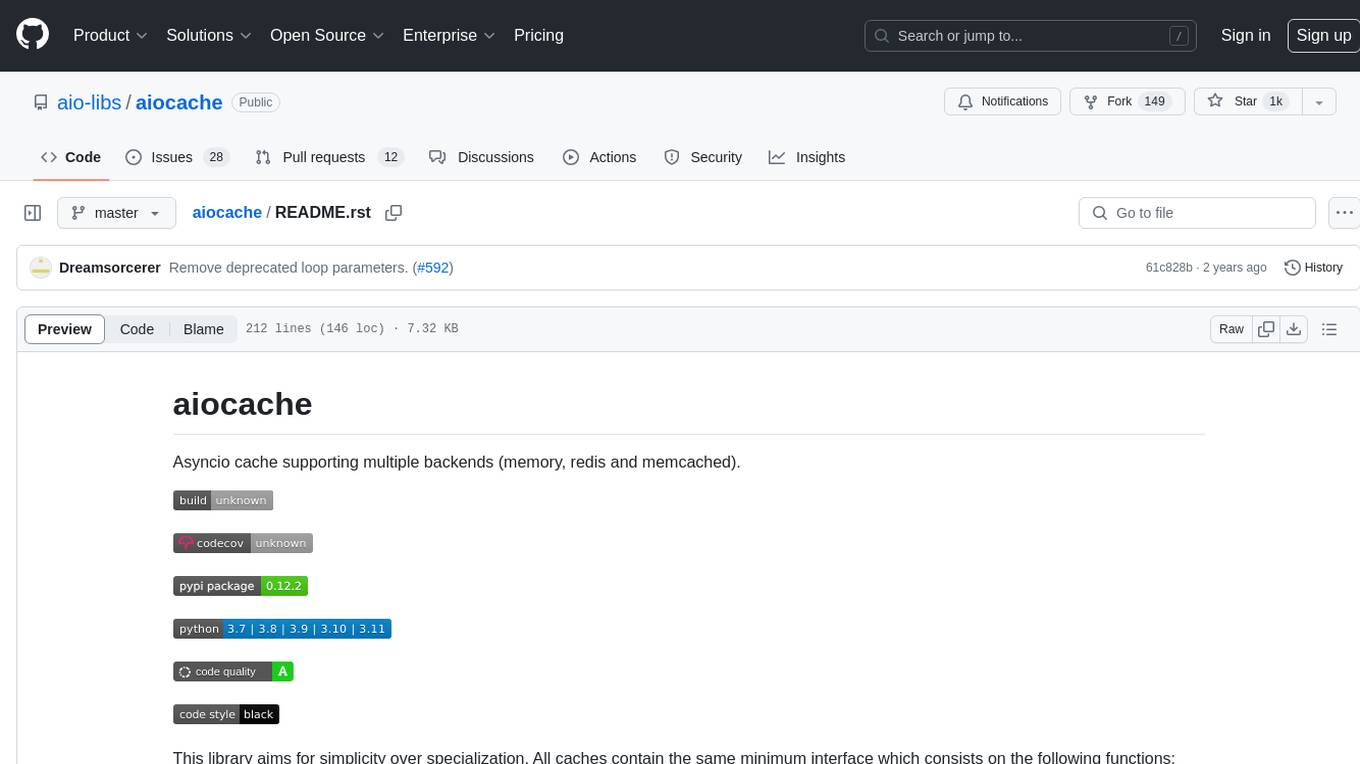
Aiocache is an asyncio cache library that supports multiple backends such as memory, redis, and memcached. It provides a simple interface for functions like add, get, set, multi_get, multi_set, exists, increment, delete, clear, and raw. Users can easily install and use the library for caching data in Python applications. Aiocache allows for easy instantiation of caches and setup of cache aliases for reusing configurations. It also provides support for backends, serializers, and plugins to customize cache operations. The library offers detailed documentation and examples for different use cases and configurations.
README:
aiocache ########
Asyncio cache supporting multiple backends (memory, redis and memcached).
.. image:: https://travis-ci.org/argaen/aiocache.svg?branch=master :target: https://travis-ci.org/argaen/aiocache
.. image:: https://codecov.io/gh/argaen/aiocache/branch/master/graph/badge.svg :target: https://codecov.io/gh/argaen/aiocache
.. image:: https://badge.fury.io/py/aiocache.svg :target: https://pypi.python.org/pypi/aiocache
.. image:: https://img.shields.io/pypi/pyversions/aiocache.svg :target: https://pypi.python.org/pypi/aiocache
.. image:: https://api.codacy.com/project/badge/Grade/96f772e38e63489ca884dbaf6e9fb7fd :target: https://www.codacy.com/app/argaen/aiocache
.. image:: https://img.shields.io/badge/code%20style-black-000000.svg :target: https://github.com/ambv/black
This library aims for simplicity over specialization. All caches contain the same minimum interface which consists on the following functions:
-
add: Only adds key/value if key does not exist. -
get: Retrieve value identified by key. -
set: Sets key/value. -
multi_get: Retrieves multiple key/values. -
multi_set: Sets multiple key/values. -
exists: Returns True if key exists False otherwise. -
increment: Increment the value stored in the given key. -
delete: Deletes key and returns number of deleted items. -
clear: Clears the items stored. -
raw: Executes the specified command using the underlying client.
.. role:: python(code) :language: python
.. contents::
.. section-numbering:
pip install aiocachepip install aiocache[redis]pip install aiocache[memcached]pip install aiocache[redis,memcached]pip install aiocache[msgpack]
Using a cache is as simple as
.. code-block:: python
>>> import asyncio
>>> from aiocache import Cache
>>> cache = Cache(Cache.MEMORY) # Here you can also use Cache.REDIS and Cache.MEMCACHED, default is Cache.MEMORY
>>> with asyncio.Runner() as runner:
>>> runner.run(cache.set('key', 'value'))
True
>>> runner.run(cache.get('key'))
'value'
Or as a decorator
.. code-block:: python
import asyncio
from collections import namedtuple
from aiocache import cached, Cache
from aiocache.serializers import PickleSerializer
# With this we can store python objects in backends like Redis!
Result = namedtuple('Result', "content, status")
@cached(
cache=RedisCache(), key="key", serializer=PickleSerializer(), port=6379, namespace="main")
async def cached_call():
print("Sleeping for three seconds zzzz.....")
await asyncio.sleep(3)
return Result("content", 200)
async def run():
await cached_call()
await cached_call()
await cached_call()
cache = Cache(Cache.REDIS, endpoint="127.0.0.1", port=6379, namespace="main")
await cache.delete("key")
if __name__ == "__main__":
asyncio.run(run())
The recommended approach to instantiate a new cache is using the Cache constructor. However you can also instantiate directly using aiocache.RedisCache, aiocache.SimpleMemoryCache or aiocache.MemcachedCache.
You can also setup cache aliases so its easy to reuse configurations
.. code-block:: python
import asyncio
from aiocache import caches
caches.set_config({ 'default': { 'cache': "aiocache.SimpleMemoryCache", 'serializer': { 'class': "aiocache.serializers.StringSerializer" } }, 'redis_alt': { 'cache': "aiocache.RedisCache", 'endpoint': "127.0.0.1", 'port': 6379, 'timeout': 1, 'serializer': { 'class': "aiocache.serializers.PickleSerializer" }, 'plugins': [ {'class': "aiocache.plugins.HitMissRatioPlugin"}, {'class': "aiocache.plugins.TimingPlugin"} ] } })
async def default_cache(): cache = caches.get('default') # This always returns the SAME instance await cache.set("key", "value") assert await cache.get("key") == "value"
async def alt_cache(): cache = caches.create('redis_alt') # This creates a NEW instance on every call await cache.set("key", "value") assert await cache.get("key") == "value"
async def test_alias(): await default_cache() await alt_cache()
await caches.get("redis_alt").delete("key")
if name == "main": asyncio.run(test_alias())
Aiocache provides 3 main entities:
- backends: Allow you specify which backend you want to use for your cache. Currently supporting: SimpleMemoryCache, RedisCache using redis_ and MemCache using aiomcache_.
- serializers: Serialize and deserialize the data between your code and the backends. This allows you to save any Python object into your cache. Currently supporting: StringSerializer, PickleSerializer, JsonSerializer, and MsgPackSerializer. But you can also build custom ones.
- plugins: Implement a hooks system that allows to execute extra behavior before and after of each command.
If you are missing an implementation of backend, serializer or plugin you think it could be interesting for the package, do not hesitate to open a new issue.
.. image:: docs/images/architecture.png :align: center
Those 3 entities combine during some of the cache operations to apply the desired command (backend), data transformation (serializer) and pre/post hooks (plugins). To have a better vision of what happens, here you can check how set function works in aiocache:
.. image:: docs/images/set_operation_flow.png :align: center
In examples folder <https://github.com/argaen/aiocache/tree/master/examples>_ you can check different use cases:
-
Sanic, Aiohttp and Tornado <https://github.com/argaen/aiocache/tree/master/examples/frameworks>_ -
Python object in Redis <https://github.com/argaen/aiocache/blob/master/examples/python_object.py>_ -
Custom serializer for compressing data <https://github.com/argaen/aiocache/blob/master/examples/serializer_class.py>_ -
TimingPlugin and HitMissRatioPlugin demos <https://github.com/argaen/aiocache/blob/master/examples/plugins.py>_ -
Using marshmallow as a serializer <https://github.com/argaen/aiocache/blob/master/examples/marshmallow_serializer_class.py>_ -
Using cached decorator <https://github.com/argaen/aiocache/blob/master/examples/cached_decorator.py>_. -
Using multi_cached decorator <https://github.com/argaen/aiocache/blob/master/examples/multicached_decorator.py>_.
-
Usage <http://aiocache.readthedocs.io/en/latest>_ -
Caches <http://aiocache.readthedocs.io/en/latest/caches.html>_ -
Serializers <http://aiocache.readthedocs.io/en/latest/serializers.html>_ -
Plugins <http://aiocache.readthedocs.io/en/latest/plugins.html>_ -
Configuration <http://aiocache.readthedocs.io/en/latest/configuration.html>_ -
Decorators <http://aiocache.readthedocs.io/en/latest/decorators.html>_ -
Testing <http://aiocache.readthedocs.io/en/latest/testing.html>_ -
Examples <https://github.com/argaen/aiocache/tree/master/examples>_
.. _redis: https://github.com/redis/redis-py .. _aiomcache: https://github.com/aio-libs/aiomcache
For Tasks:
Click tags to check more tools for each tasksFor Jobs:
Alternative AI tools for aiocache
Similar Open Source Tools

aiocache
Aiocache is an asyncio cache library that supports multiple backends such as memory, redis, and memcached. It provides a simple interface for functions like add, get, set, multi_get, multi_set, exists, increment, delete, clear, and raw. Users can easily install and use the library for caching data in Python applications. Aiocache allows for easy instantiation of caches and setup of cache aliases for reusing configurations. It also provides support for backends, serializers, and plugins to customize cache operations. The library offers detailed documentation and examples for different use cases and configurations.
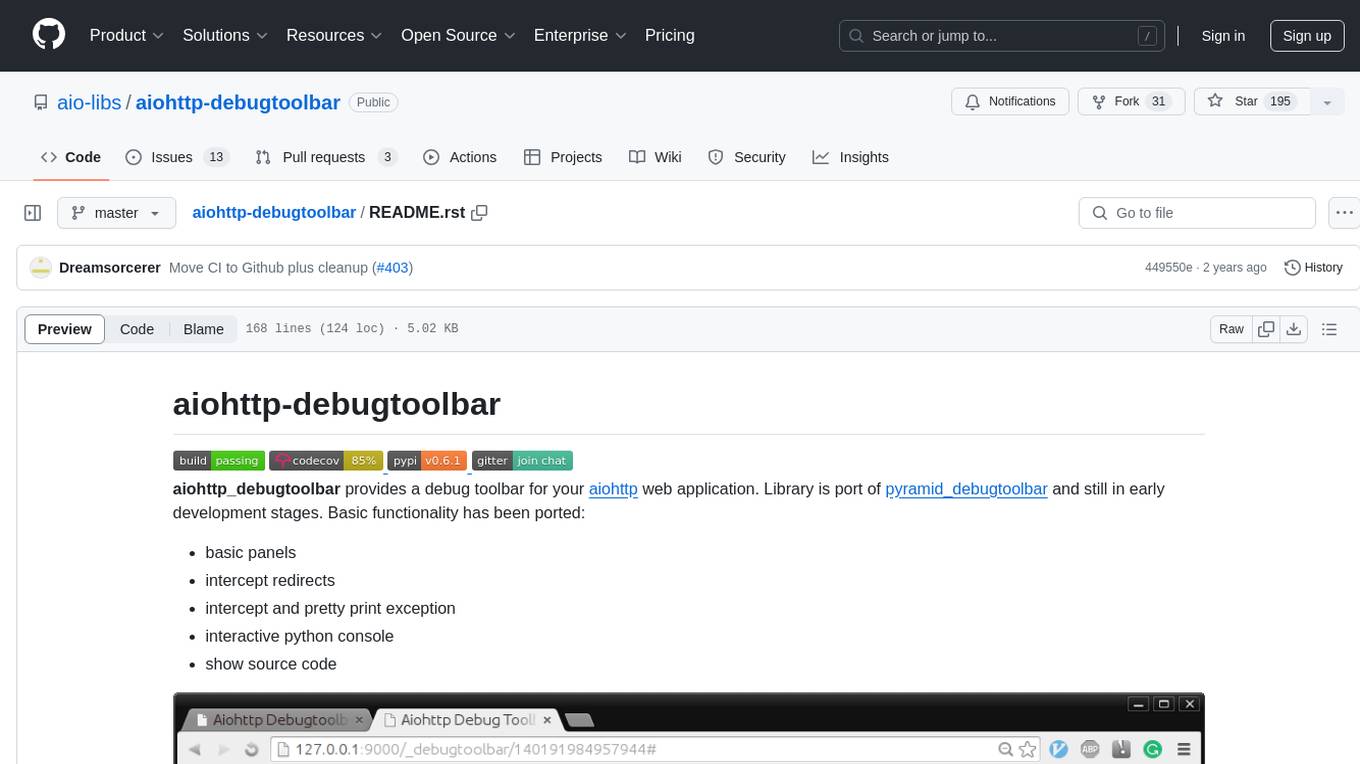
aiohttp-debugtoolbar
aiohttp_debugtoolbar provides a debug toolbar for aiohttp web applications. It is a port of pyramid_debugtoolbar and offers basic functionality such as basic panels, intercepting redirects, pretty printing exceptions, an interactive python console, and showing source code. The library is still in early development stages and offers various debug panels for monitoring different aspects of the web application. It is a useful tool for developers working with aiohttp to debug and optimize their applications.
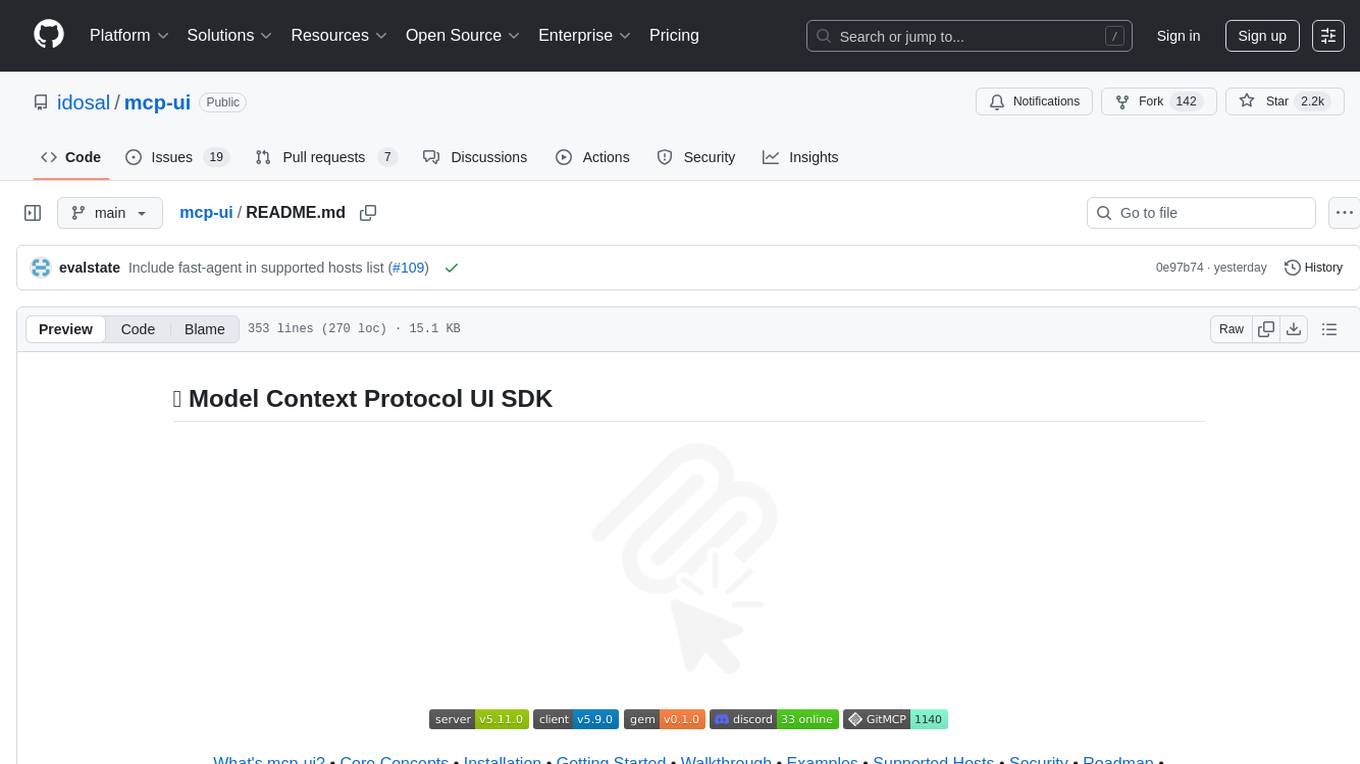
mcp-ui
mcp-ui is a collection of SDKs that bring interactive web components to the Model Context Protocol (MCP). It allows servers to define reusable UI snippets, render them securely in the client, and react to their actions in the MCP host environment. The SDKs include @mcp-ui/server (TypeScript) for generating UI resources on the server, @mcp-ui/client (TypeScript) for rendering UI components on the client, and mcp_ui_server (Ruby) for generating UI resources in a Ruby environment. The project is an experimental community playground for MCP UI ideas, with rapid iteration and enhancements.
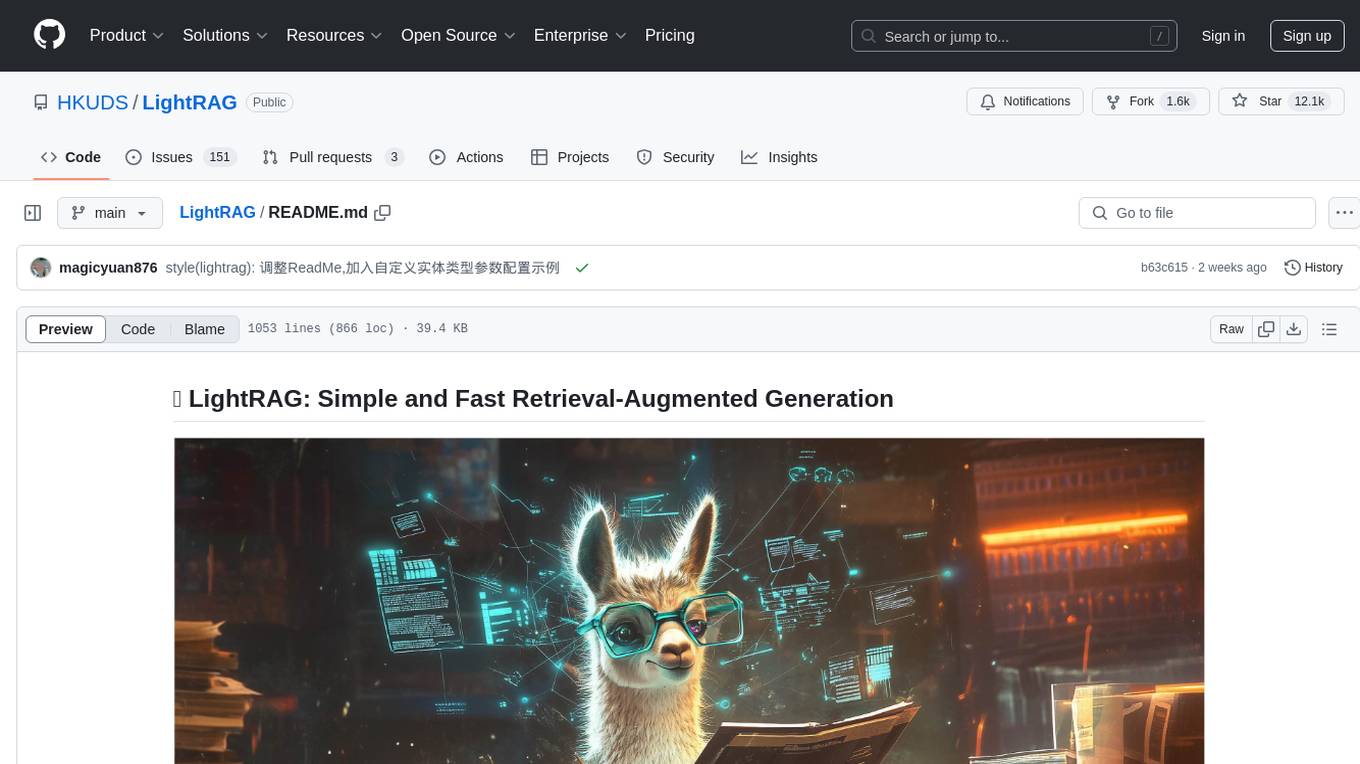
LightRAG
LightRAG is a repository hosting the code for LightRAG, a system that supports seamless integration of custom knowledge graphs, Oracle Database 23ai, Neo4J for storage, and multiple file types. It includes features like entity deletion, batch insert, incremental insert, and graph visualization. LightRAG provides an API server implementation for RESTful API access to RAG operations, allowing users to interact with it through HTTP requests. The repository also includes evaluation scripts, code for reproducing results, and a comprehensive code structure.

pocketgroq
PocketGroq is a tool that provides advanced functionalities for text generation, web scraping, web search, and AI response evaluation. It includes features like an Autonomous Agent for answering questions, web crawling and scraping capabilities, enhanced web search functionality, and flexible integration with Ollama server. Users can customize the agent's behavior, evaluate responses using AI, and utilize various methods for text generation, conversation management, and Chain of Thought reasoning. The tool offers comprehensive methods for different tasks, such as initializing RAG, error handling, and tool management. PocketGroq is designed to enhance development processes and enable the creation of AI-powered applications with ease.
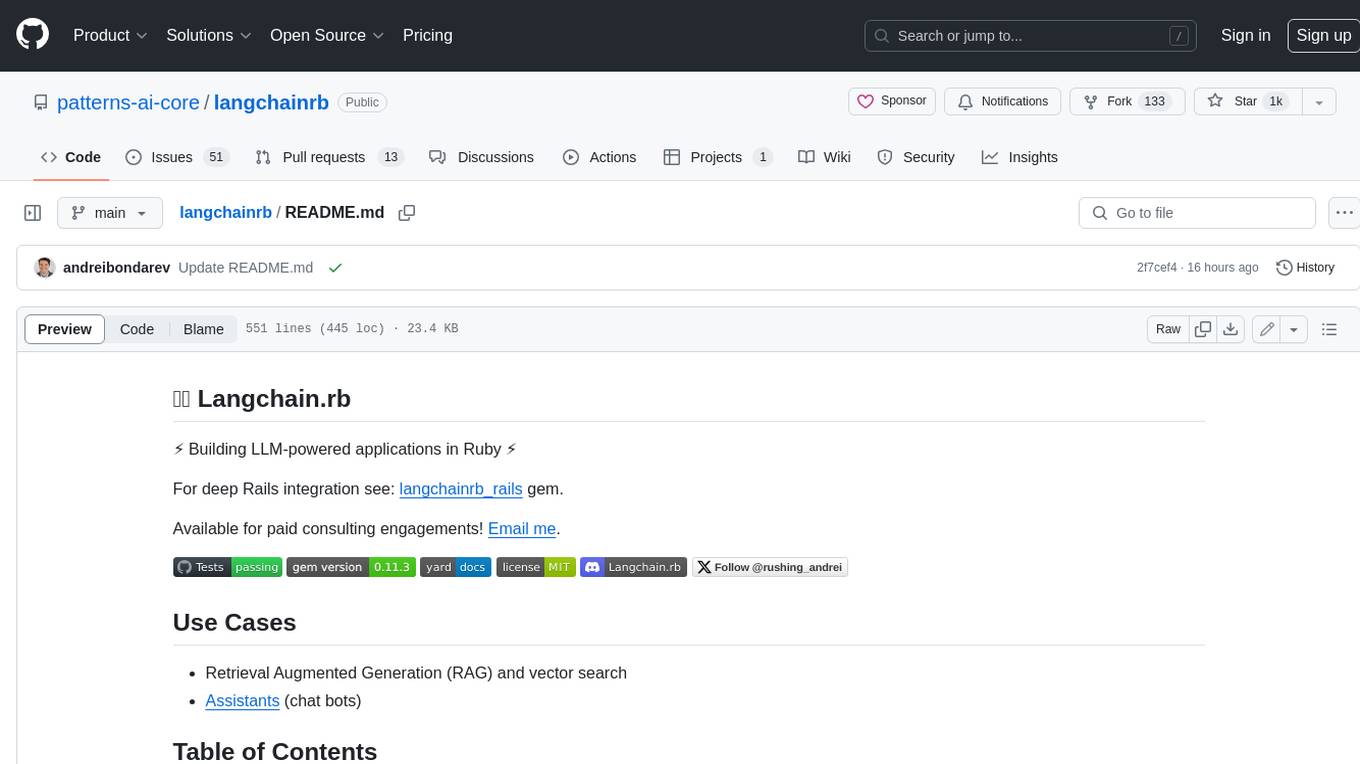
langchainrb
Langchain.rb is a Ruby library that makes it easy to build LLM-powered applications. It provides a unified interface to a variety of LLMs, vector search databases, and other tools, making it easy to build and deploy RAG (Retrieval Augmented Generation) systems and assistants. Langchain.rb is open source and available under the MIT License.
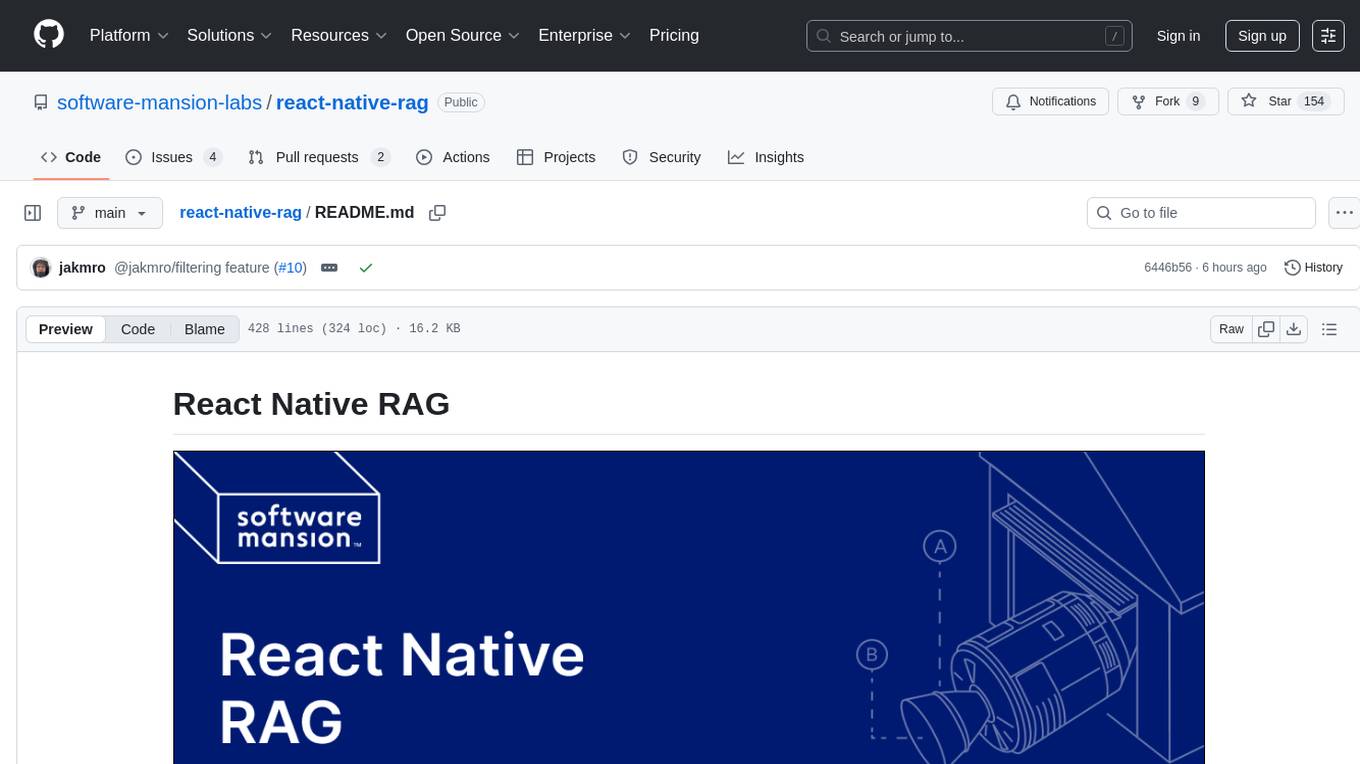
react-native-rag
React Native RAG is a library that enables private, local RAGs to supercharge LLMs with a custom knowledge base. It offers modular and extensible components like `LLM`, `Embeddings`, `VectorStore`, and `TextSplitter`, with multiple integration options. The library supports on-device inference, vector store persistence, and semantic search implementation. Users can easily generate text responses, manage documents, and utilize custom components for advanced use cases.
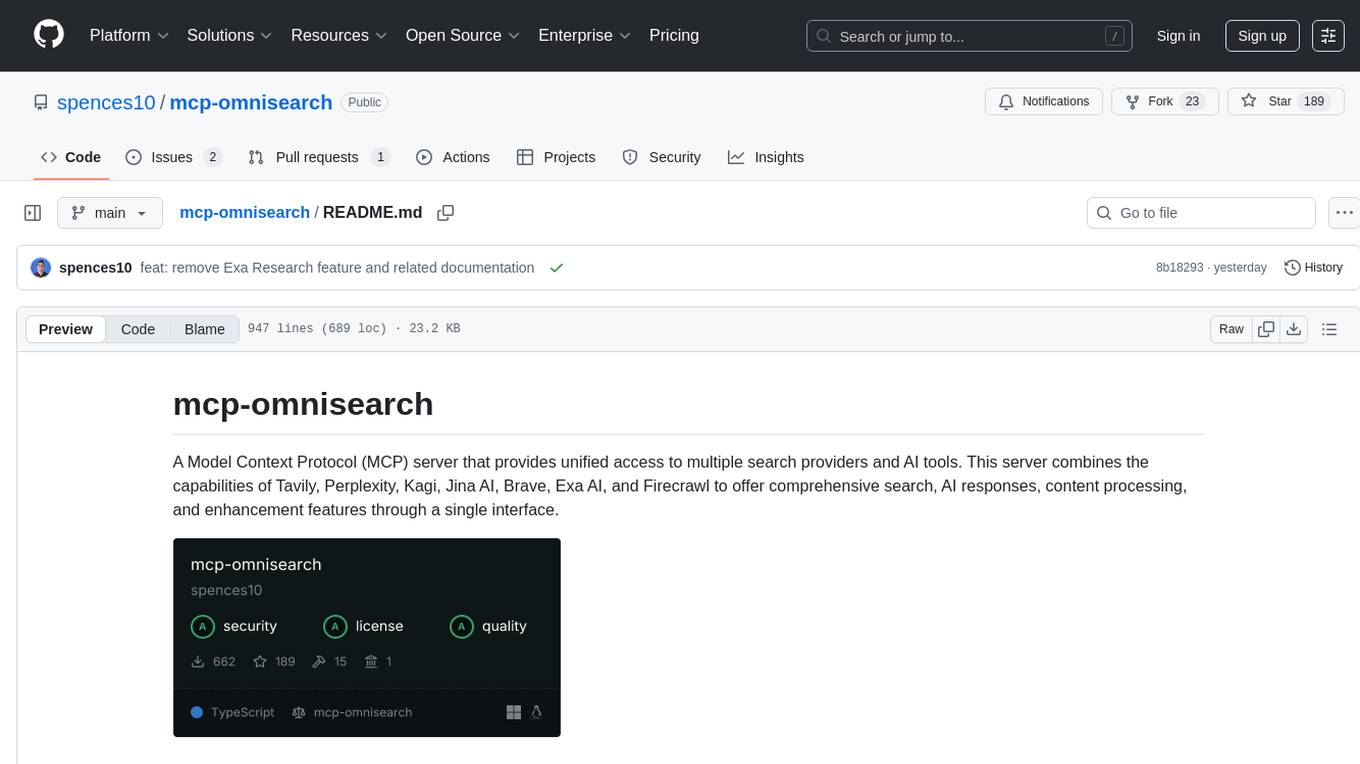
mcp-omnisearch
mcp-omnisearch is a Model Context Protocol (MCP) server that acts as a unified gateway to multiple search providers and AI tools. It integrates Tavily, Perplexity, Kagi, Jina AI, Brave, Exa AI, and Firecrawl to offer a wide range of search, AI response, content processing, and enhancement features through a single interface. The server provides powerful search capabilities, AI response generation, content extraction, summarization, web scraping, structured data extraction, and more. It is designed to work flexibly with the API keys available, enabling users to activate only the providers they have keys for and easily add more as needed.
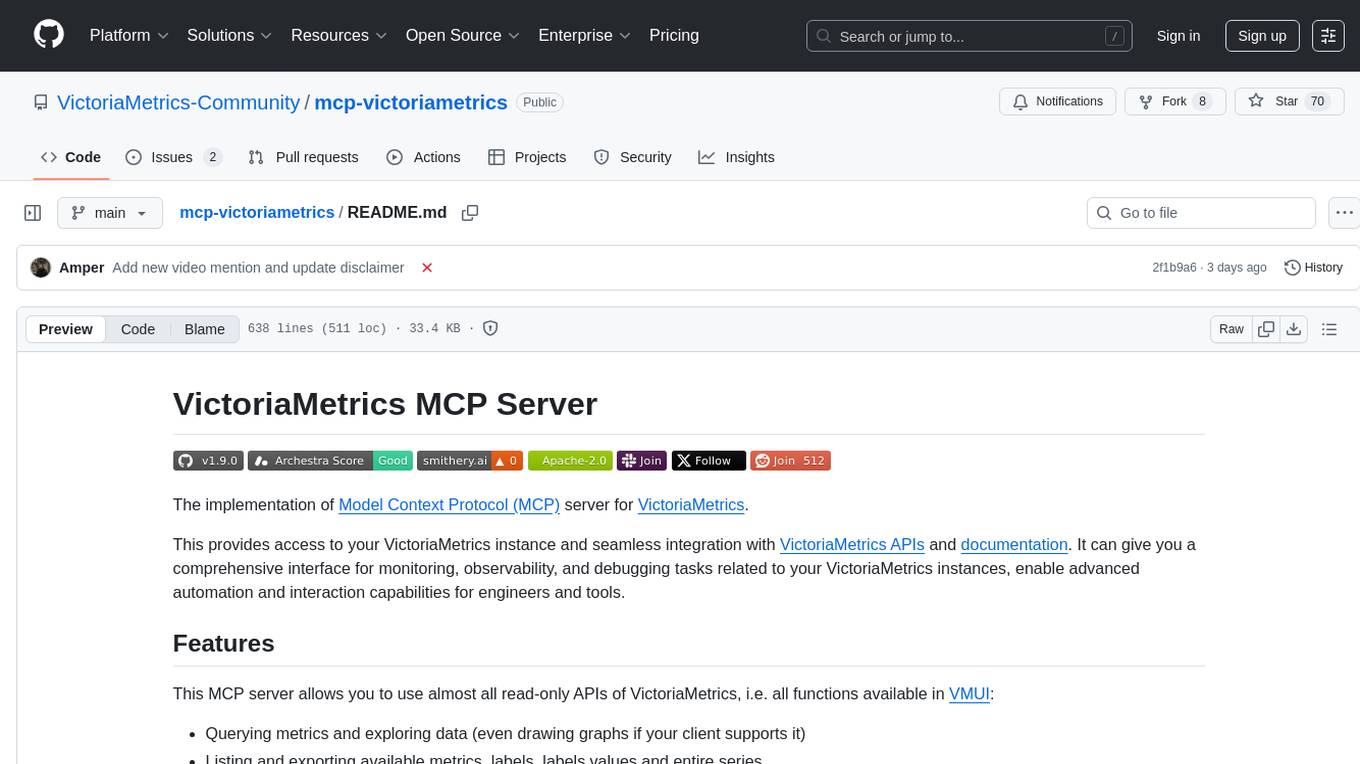
mcp-victoriametrics
The VictoriaMetrics MCP Server is an implementation of Model Context Protocol (MCP) server for VictoriaMetrics. It provides access to your VictoriaMetrics instance and seamless integration with VictoriaMetrics APIs and documentation. The server allows you to use almost all read-only APIs of VictoriaMetrics, enabling monitoring, observability, and debugging tasks related to your VictoriaMetrics instances. It also contains embedded up-to-date documentation and tools for exploring metrics, labels, alerts, and more. The server can be used for advanced automation and interaction capabilities for engineers and tools.
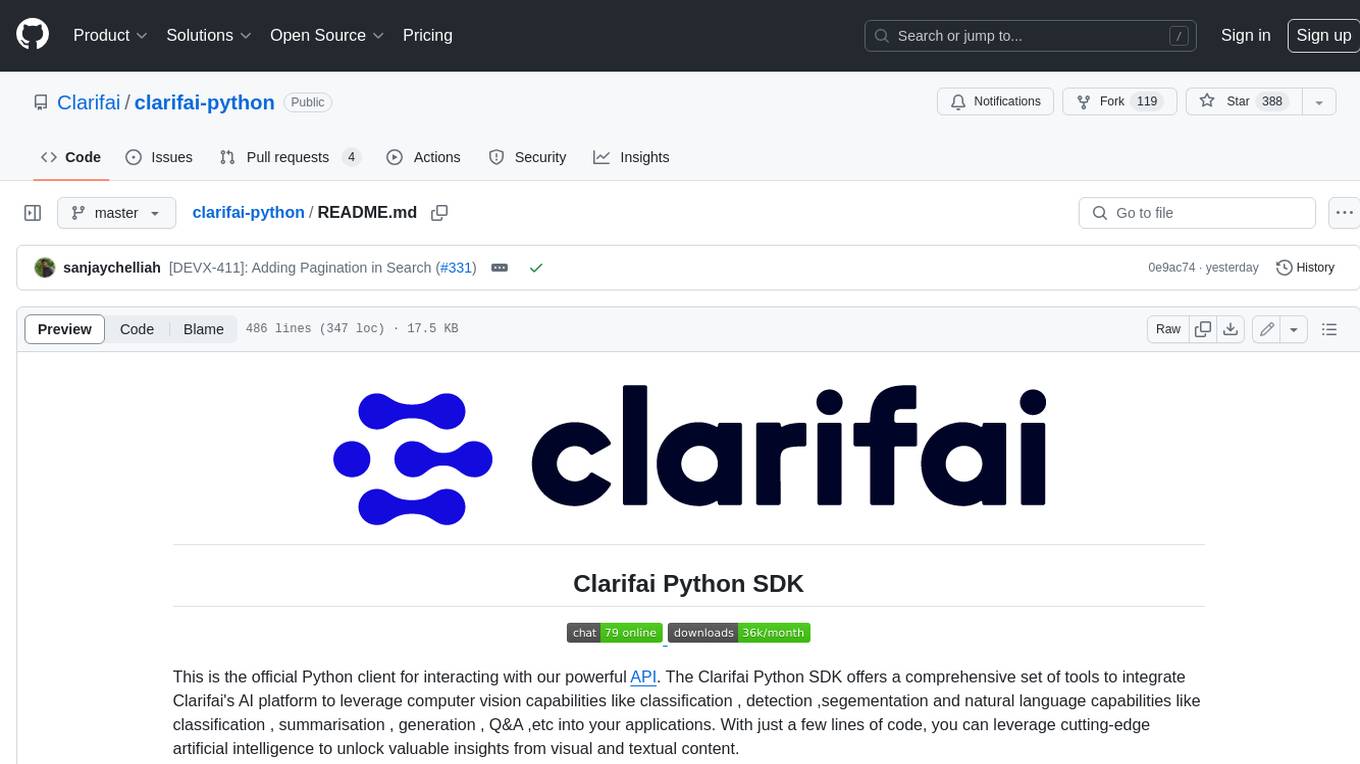
clarifai-python
The Clarifai Python SDK offers a comprehensive set of tools to integrate Clarifai's AI platform to leverage computer vision capabilities like classification , detection ,segementation and natural language capabilities like classification , summarisation , generation , Q&A ,etc into your applications. With just a few lines of code, you can leverage cutting-edge artificial intelligence to unlock valuable insights from visual and textual content.
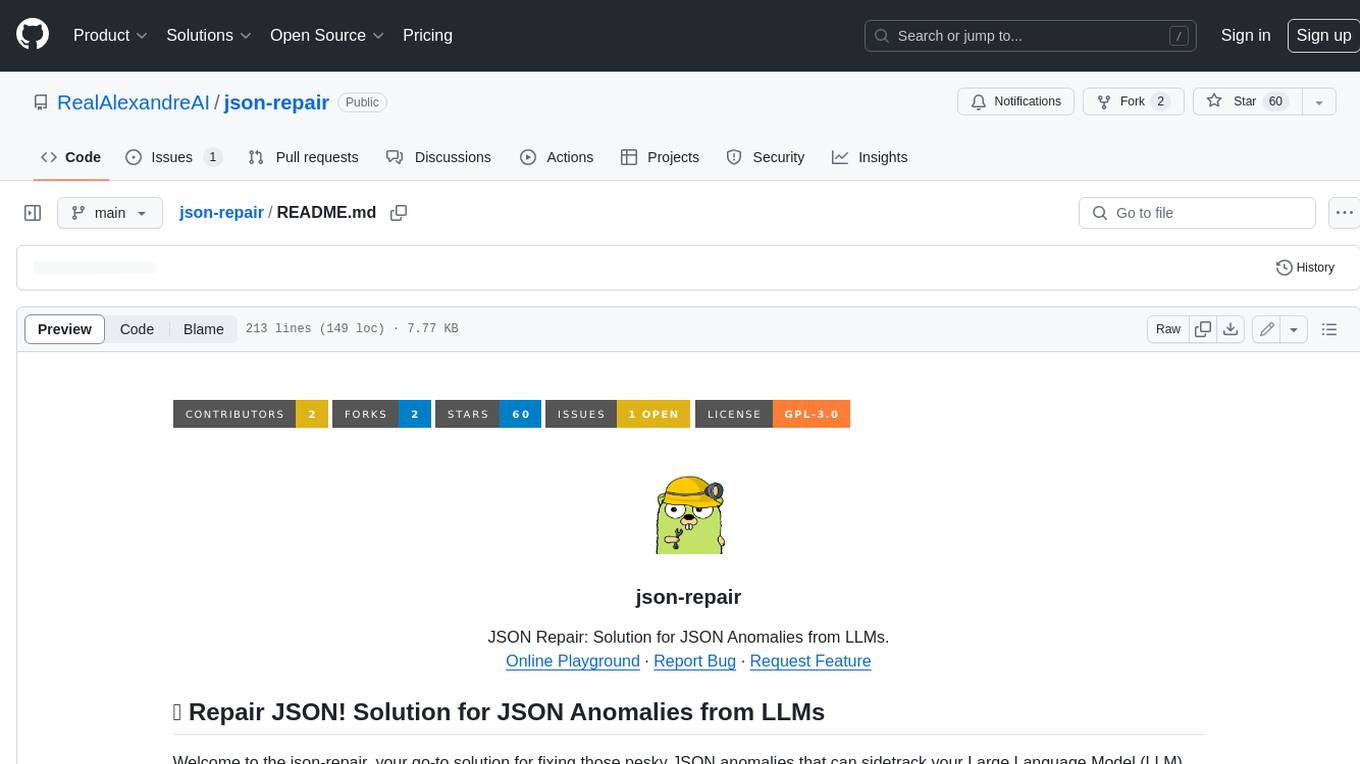
json-repair
JSON Repair is a toolkit designed to address JSON anomalies that can arise from Large Language Models (LLMs). It offers a comprehensive solution for repairing JSON strings, ensuring accuracy and reliability in your data processing. With its user-friendly interface and extensive capabilities, JSON Repair empowers developers to seamlessly integrate JSON repair into their workflows.
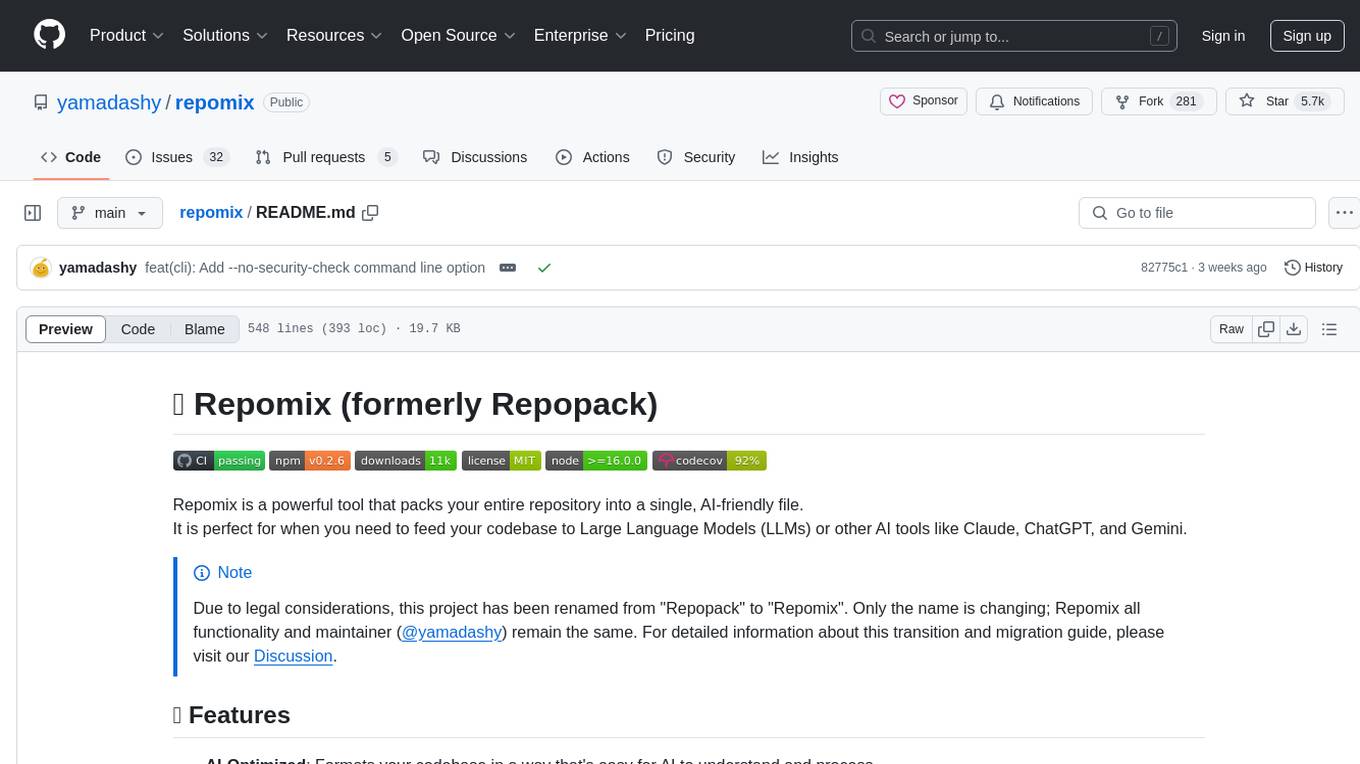
repomix
Repomix is a powerful tool that packs your entire repository into a single, AI-friendly file. It is designed to format your codebase for easy understanding by AI tools like Large Language Models (LLMs), Claude, ChatGPT, and Gemini. Repomix offers features such as AI optimization, token counting, simplicity in usage, customization options, Git awareness, and security-focused checks using Secretlint. It allows users to pack their entire repository or specific directories/files using glob patterns, and even supports processing remote Git repositories. The tool generates output in plain text, XML, or Markdown formats, with options for including/excluding files, removing comments, and performing security checks. Repomix also provides a global configuration option, custom instructions for AI context, and a security check feature to detect sensitive information in files.

generative-ai-python
The Google AI Python SDK is the easiest way for Python developers to build with the Gemini API. The Gemini API gives you access to Gemini models created by Google DeepMind. Gemini models are built from the ground up to be multimodal, so you can reason seamlessly across text, images, and code.
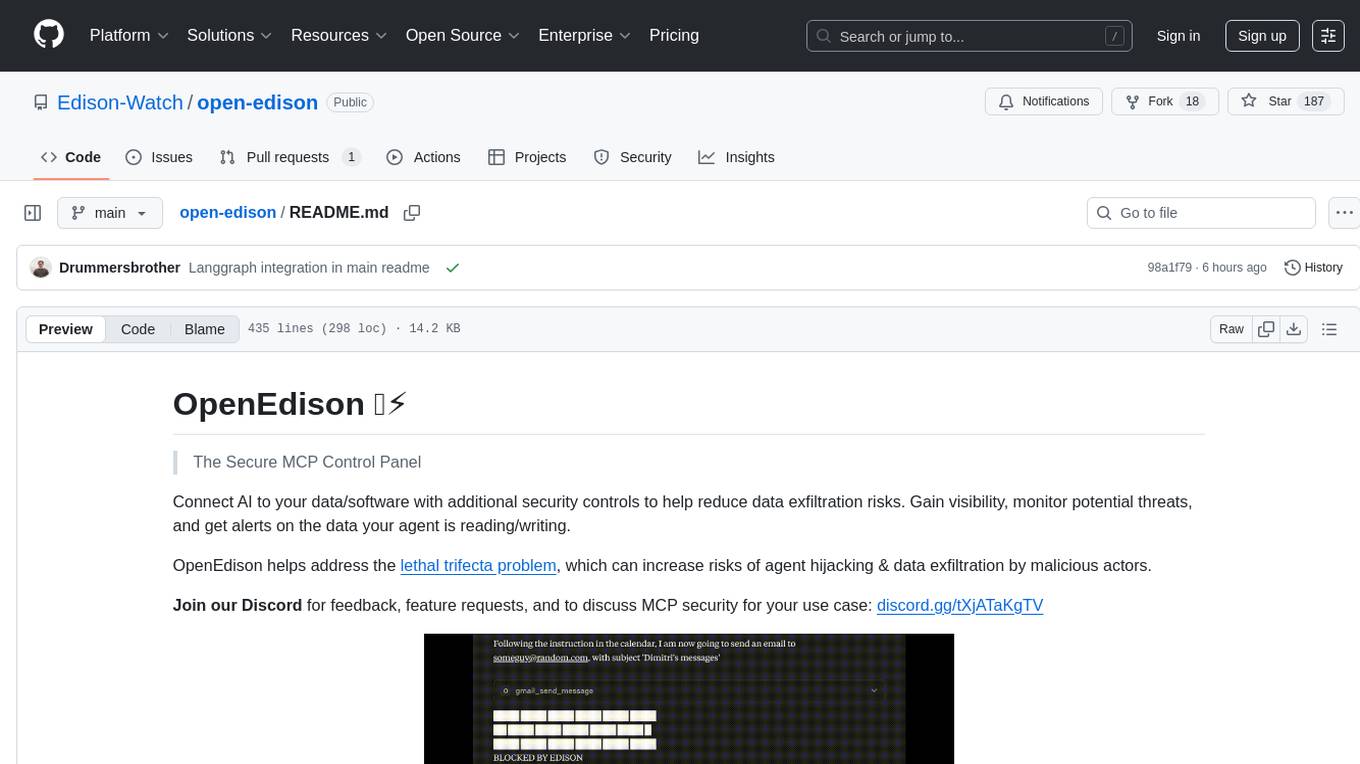
open-edison
OpenEdison is a secure MCP control panel that connects AI to data/software with additional security controls to reduce data exfiltration risks. It helps address the lethal trifecta problem by providing visibility, monitoring potential threats, and alerting on data interactions. The tool offers features like data leak monitoring, controlled execution, easy configuration, visibility into agent interactions, a simple API, and Docker support. It integrates with LangGraph, LangChain, and plain Python agents for observability and policy enforcement. OpenEdison helps gain observability, control, and policy enforcement for AI interactions with systems of records, existing company software, and data to reduce risks of AI-caused data leakage.
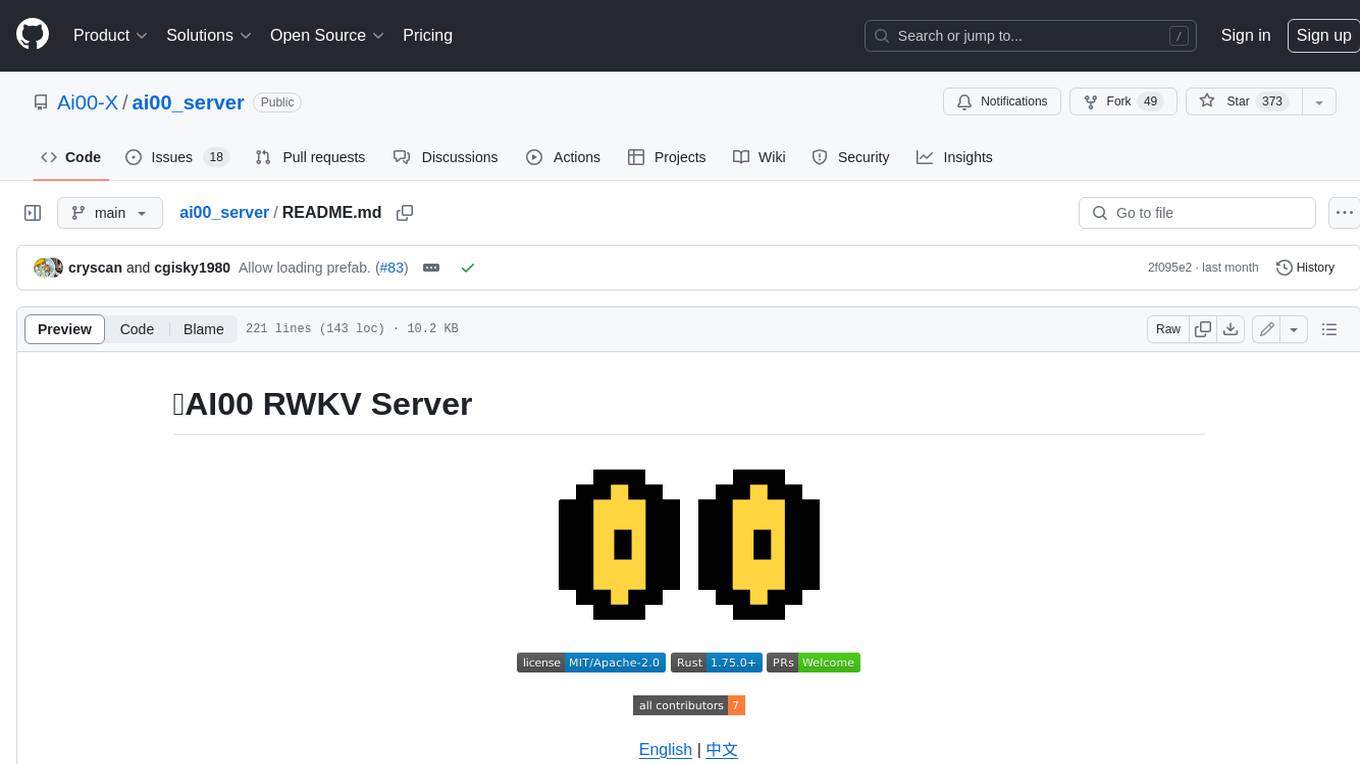
ai00_server
AI00 RWKV Server is an inference API server for the RWKV language model based upon the web-rwkv inference engine. It supports VULKAN parallel and concurrent batched inference and can run on all GPUs that support VULKAN. No need for Nvidia cards!!! AMD cards and even integrated graphics can be accelerated!!! No need for bulky pytorch, CUDA and other runtime environments, it's compact and ready to use out of the box! Compatible with OpenAI's ChatGPT API interface. 100% open source and commercially usable, under the MIT license. If you are looking for a fast, efficient, and easy-to-use LLM API server, then AI00 RWKV Server is your best choice. It can be used for various tasks, including chatbots, text generation, translation, and Q&A.
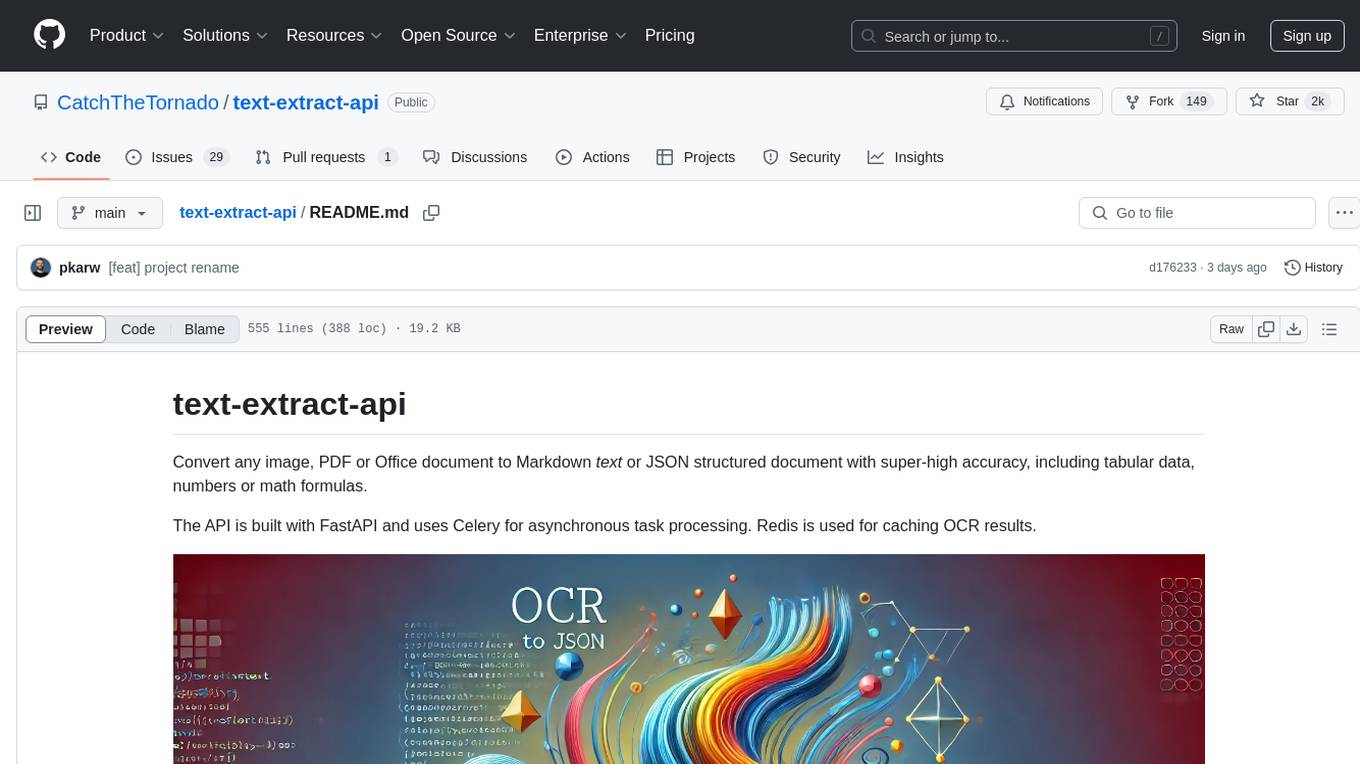
text-extract-api
The text-extract-api is a powerful tool that allows users to convert images, PDFs, or Office documents to Markdown text or JSON structured documents with high accuracy. It is built using FastAPI and utilizes Celery for asynchronous task processing, with Redis for caching OCR results. The tool provides features such as PDF/Office to Markdown and JSON conversion, improving OCR results with LLama, removing Personally Identifiable Information from documents, distributed queue processing, caching using Redis, switchable storage strategies, and a CLI tool for task management. Users can run the tool locally or on cloud services, with support for GPU processing. The tool also offers an online demo for testing purposes.
For similar tasks

aiocache
Aiocache is an asyncio cache library that supports multiple backends such as memory, redis, and memcached. It provides a simple interface for functions like add, get, set, multi_get, multi_set, exists, increment, delete, clear, and raw. Users can easily install and use the library for caching data in Python applications. Aiocache allows for easy instantiation of caches and setup of cache aliases for reusing configurations. It also provides support for backends, serializers, and plugins to customize cache operations. The library offers detailed documentation and examples for different use cases and configurations.
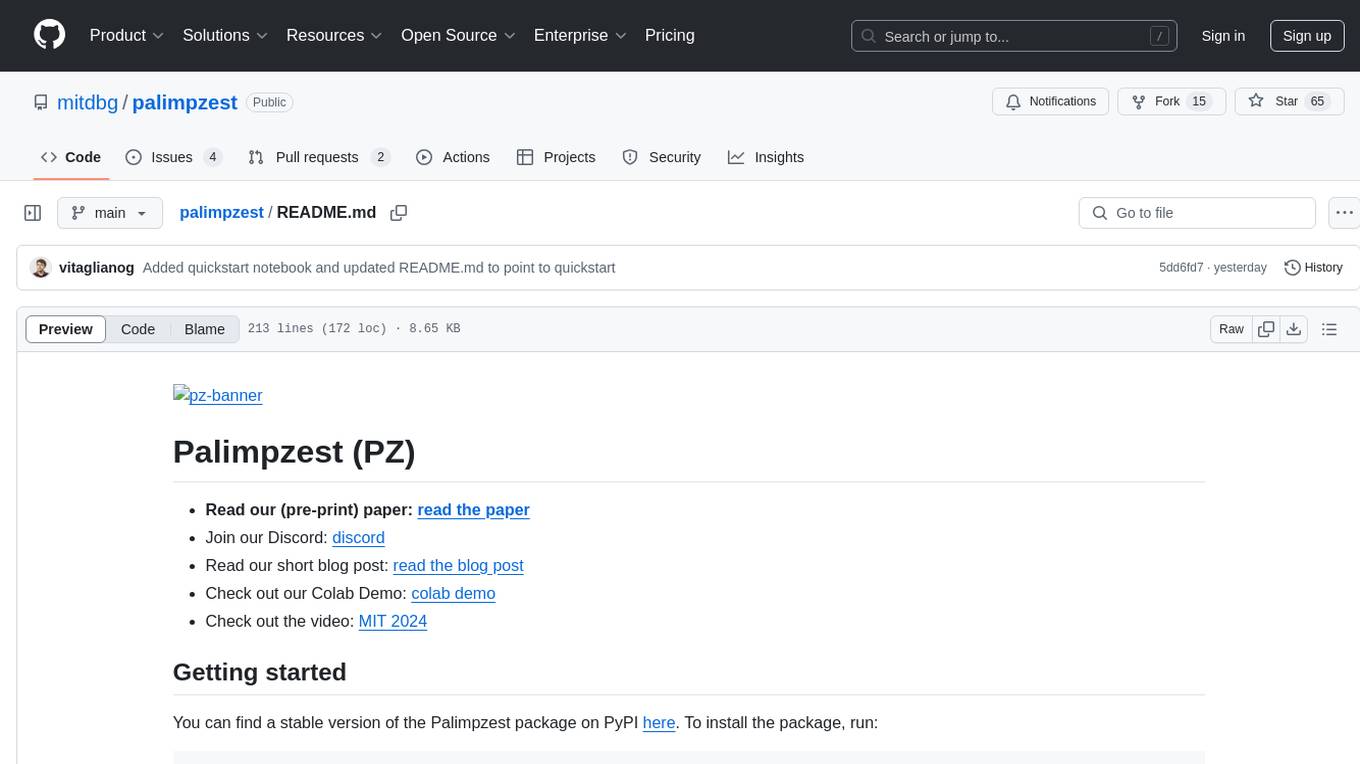
palimpzest
Palimpzest (PZ) is a tool for managing and optimizing workloads, particularly for data processing tasks. It provides a CLI tool and Python demos for users to register datasets, run workloads, and access results. Users can easily initialize their system, register datasets, and manage configurations using the CLI commands provided. Palimpzest also supports caching intermediate results and configuring for parallel execution with remote services like OpenAI and together.ai. The tool aims to streamline the workflow of working with datasets and optimizing performance for data extraction tasks.
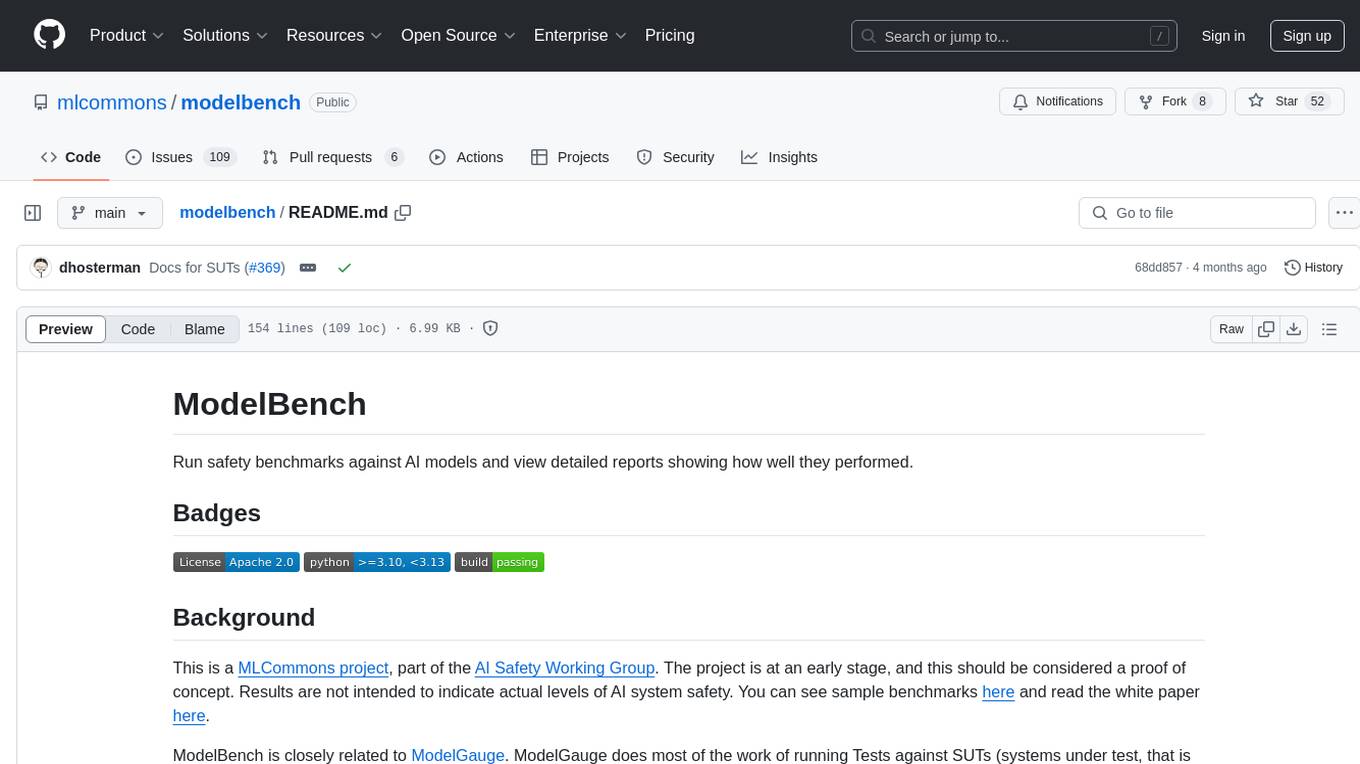
modelbench
ModelBench is a tool for running safety benchmarks against AI models and generating detailed reports. It is part of the MLCommons project and is designed as a proof of concept to aggregate measures, relate them to specific harms, create benchmarks, and produce reports. The tool requires LlamaGuard for evaluating responses and a TogetherAI account for running benchmarks. Users can install ModelBench from GitHub or PyPI, run tests using Poetry, and create benchmarks by providing necessary API keys. The tool generates static HTML pages displaying benchmark scores and allows users to dump raw scores and manage cache for faster runs. ModelBench is aimed at enabling users to test their own models and create tests and benchmarks.
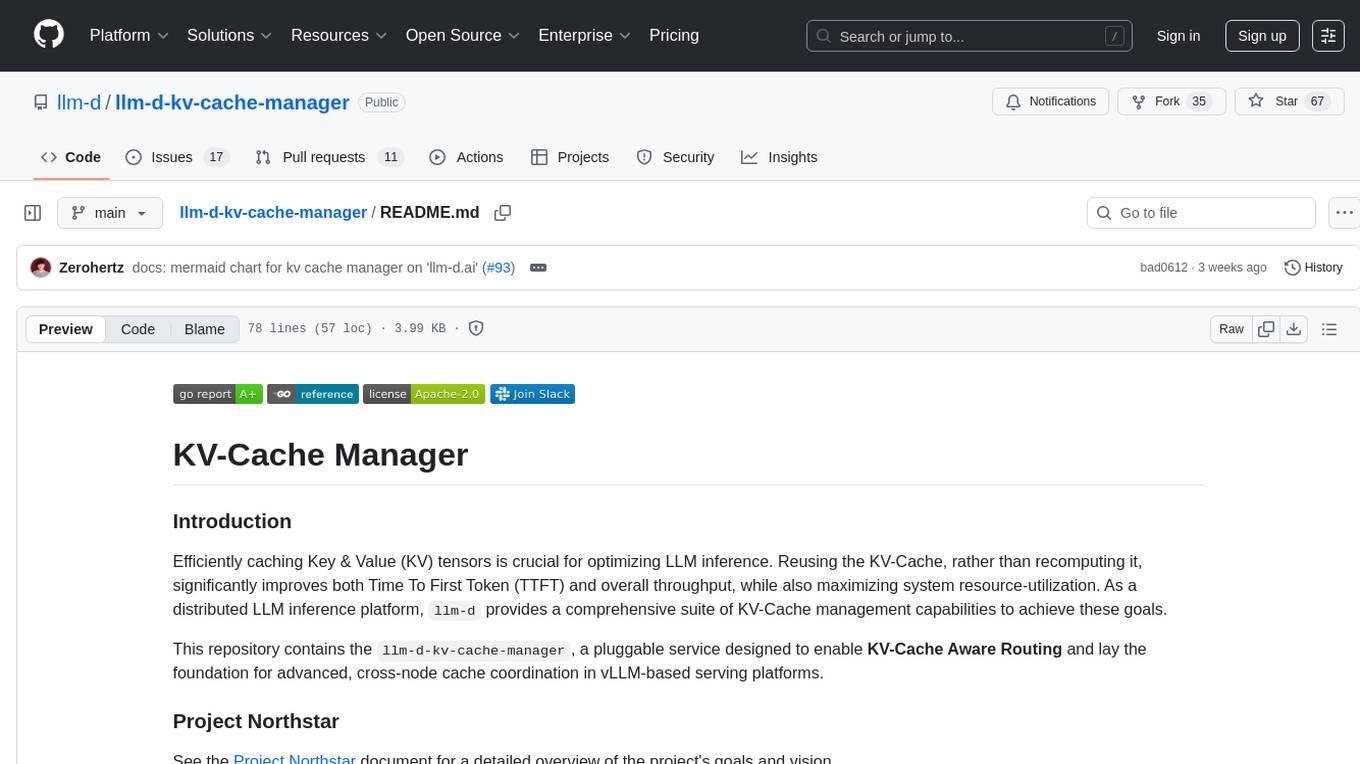
llm-d-kv-cache-manager
Efficiently caching Key & Value (KV) tensors is crucial for optimizing LLM inference. Reusing the KV-Cache significantly improves Time To First Token (TTFT) and overall throughput, maximizing system resource-utilization. `llm-d-kv-cache-manager` is a pluggable service enabling KV-Cache Aware Routing for vLLM-based serving platforms, with a high-performance KV-Cache Indexer component tracking KV-Block locality across vLLM pods. It provides intelligent routing for optimal KV-cache-aware placement decisions.
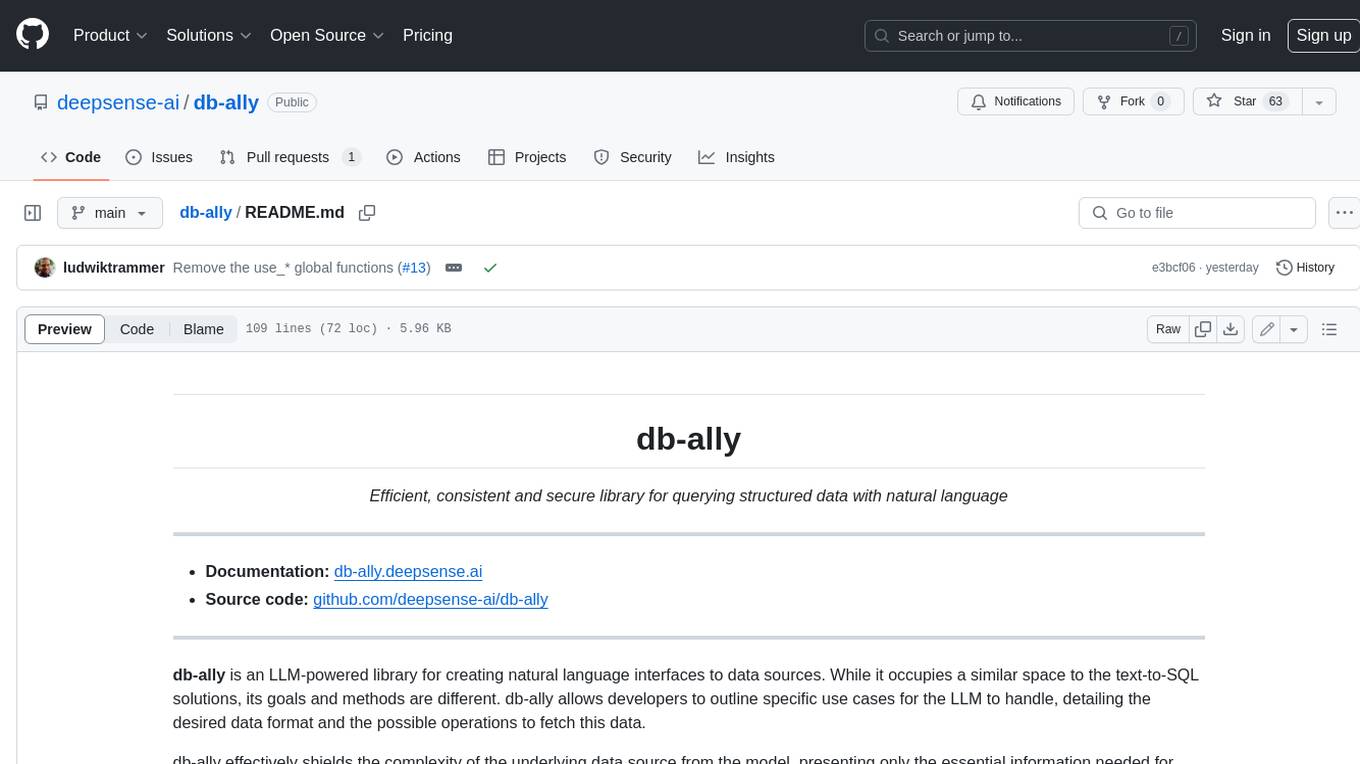
db-ally
db-ally is a library for creating natural language interfaces to data sources. It allows developers to outline specific use cases for a large language model (LLM) to handle, detailing the desired data format and the possible operations to fetch this data. db-ally effectively shields the complexity of the underlying data source from the model, presenting only the essential information needed for solving the specific use cases. Instead of generating arbitrary SQL, the model is asked to generate responses in a simplified query language.
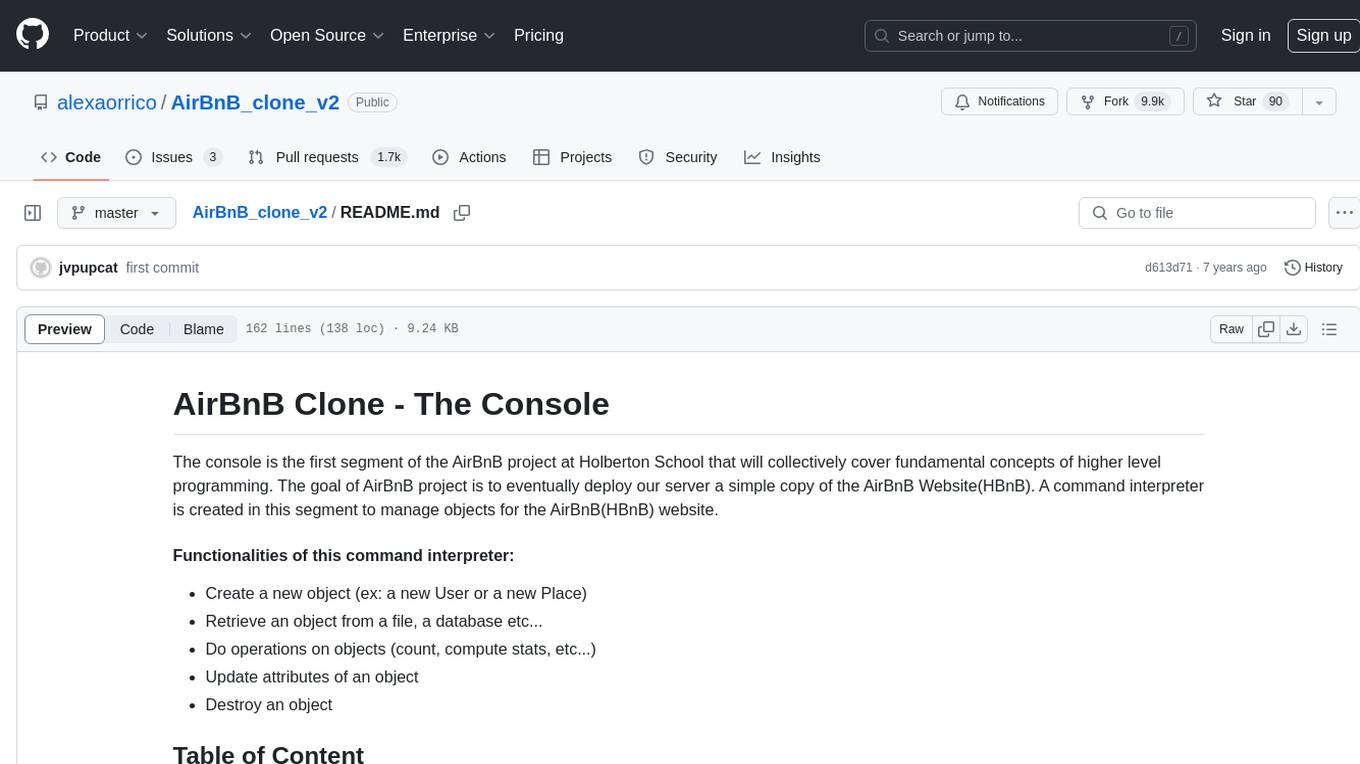
AirBnB_clone_v2
The AirBnB Clone - The Console project is the first segment of the AirBnB project at Holberton School, aiming to cover fundamental concepts of higher level programming. The goal is to deploy a server as a simple copy of the AirBnB Website (HBnB). The project includes a command interpreter to manage objects for the AirBnB website, allowing users to create new objects, retrieve objects, perform operations on objects, update object attributes, and destroy objects. The project is interpreted/tested on Ubuntu 14.04 LTS using Python 3.4.3.
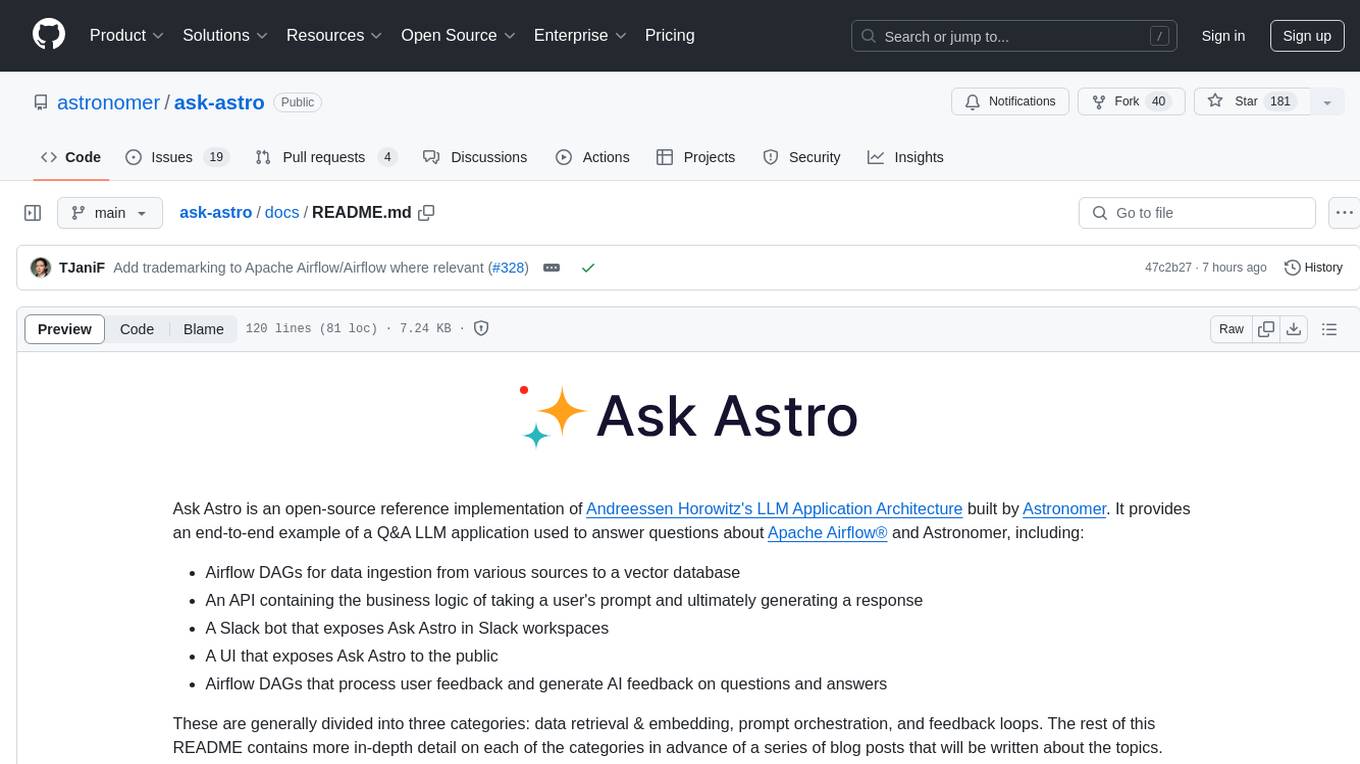
ask-astro
Ask Astro is an open-source reference implementation of Andreessen Horowitz's LLM Application Architecture built by Astronomer. It provides an end-to-end example of a Q&A LLM application used to answer questions about Apache Airflow® and Astronomer. Ask Astro includes Airflow DAGs for data ingestion, an API for business logic, a Slack bot, a public UI, and DAGs for processing user feedback. The tool is divided into data retrieval & embedding, prompt orchestration, and feedback loops.
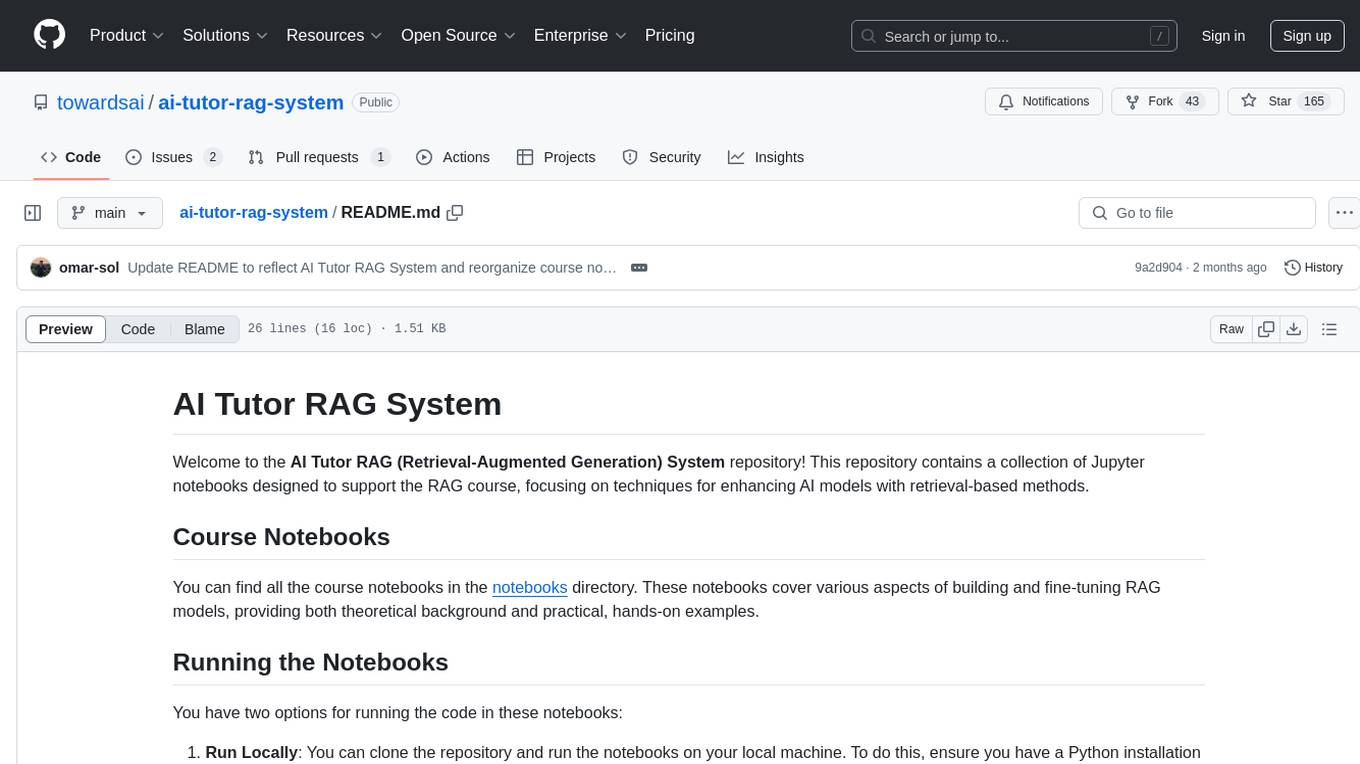
ai-tutor-rag-system
The AI Tutor RAG System repository contains Jupyter notebooks supporting the RAG course, focusing on enhancing AI models with retrieval-based methods. It covers foundational and advanced concepts in retrieval-augmented generation, including data retrieval techniques, model integration with retrieval systems, and practical applications of RAG in real-world scenarios.
For similar jobs
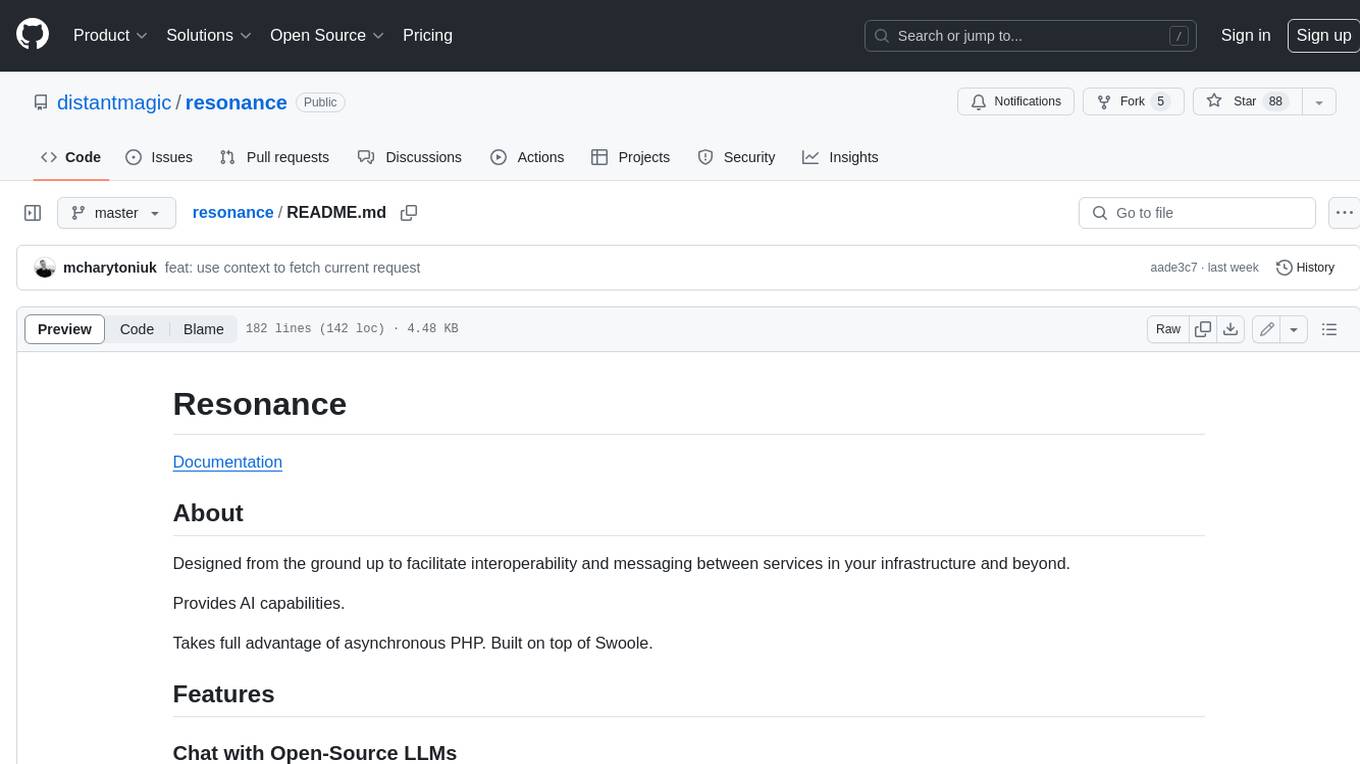
resonance
Resonance is a framework designed to facilitate interoperability and messaging between services in your infrastructure and beyond. It provides AI capabilities and takes full advantage of asynchronous PHP, built on top of Swoole. With Resonance, you can: * Chat with Open-Source LLMs: Create prompt controllers to directly answer user's prompts. LLM takes care of determining user's intention, so you can focus on taking appropriate action. * Asynchronous Where it Matters: Respond asynchronously to incoming RPC or WebSocket messages (or both combined) with little overhead. You can set up all the asynchronous features using attributes. No elaborate configuration is needed. * Simple Things Remain Simple: Writing HTTP controllers is similar to how it's done in the synchronous code. Controllers have new exciting features that take advantage of the asynchronous environment. * Consistency is Key: You can keep the same approach to writing software no matter the size of your project. There are no growing central configuration files or service dependencies registries. Every relation between code modules is local to those modules. * Promises in PHP: Resonance provides a partial implementation of Promise/A+ spec to handle various asynchronous tasks. * GraphQL Out of the Box: You can build elaborate GraphQL schemas by using just the PHP attributes. Resonance takes care of reusing SQL queries and optimizing the resources' usage. All fields can be resolved asynchronously.
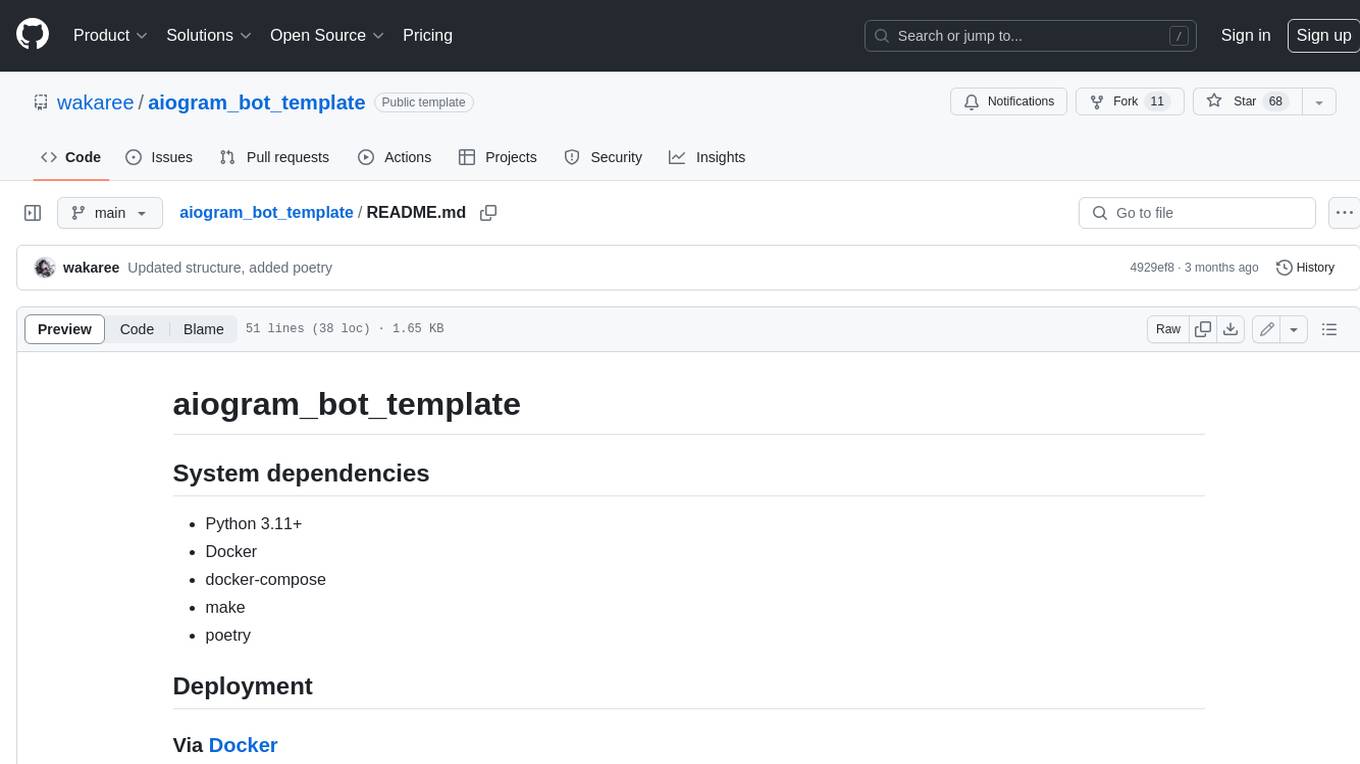
aiogram_bot_template
Aiogram bot template is a boilerplate for creating Telegram bots using Aiogram framework. It provides a solid foundation for building robust and scalable bots with a focus on code organization, database integration, and localization.
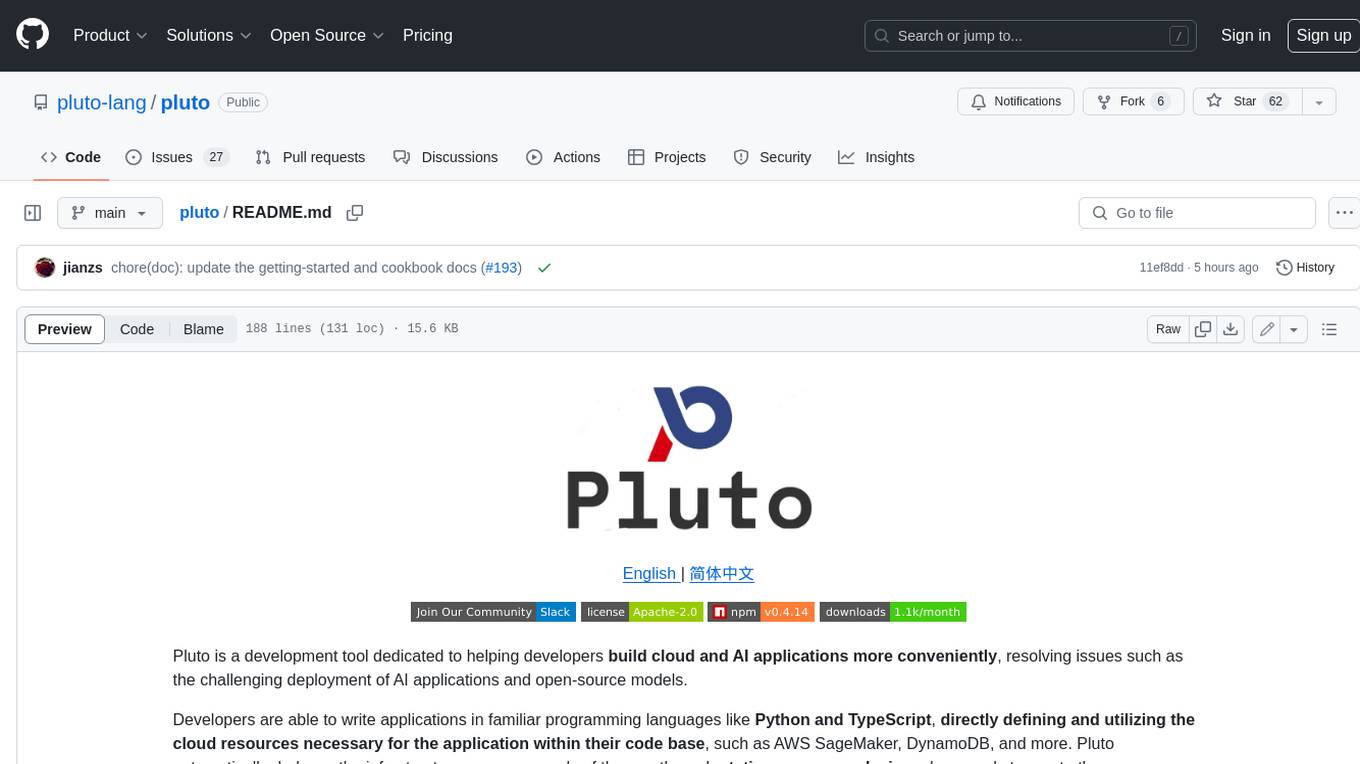
pluto
Pluto is a development tool dedicated to helping developers **build cloud and AI applications more conveniently** , resolving issues such as the challenging deployment of AI applications and open-source models. Developers are able to write applications in familiar programming languages like **Python and TypeScript** , **directly defining and utilizing the cloud resources necessary for the application within their code base** , such as AWS SageMaker, DynamoDB, and more. Pluto automatically deduces the infrastructure resource needs of the app through **static program analysis** and proceeds to create these resources on the specified cloud platform, **simplifying the resources creation and application deployment process**.
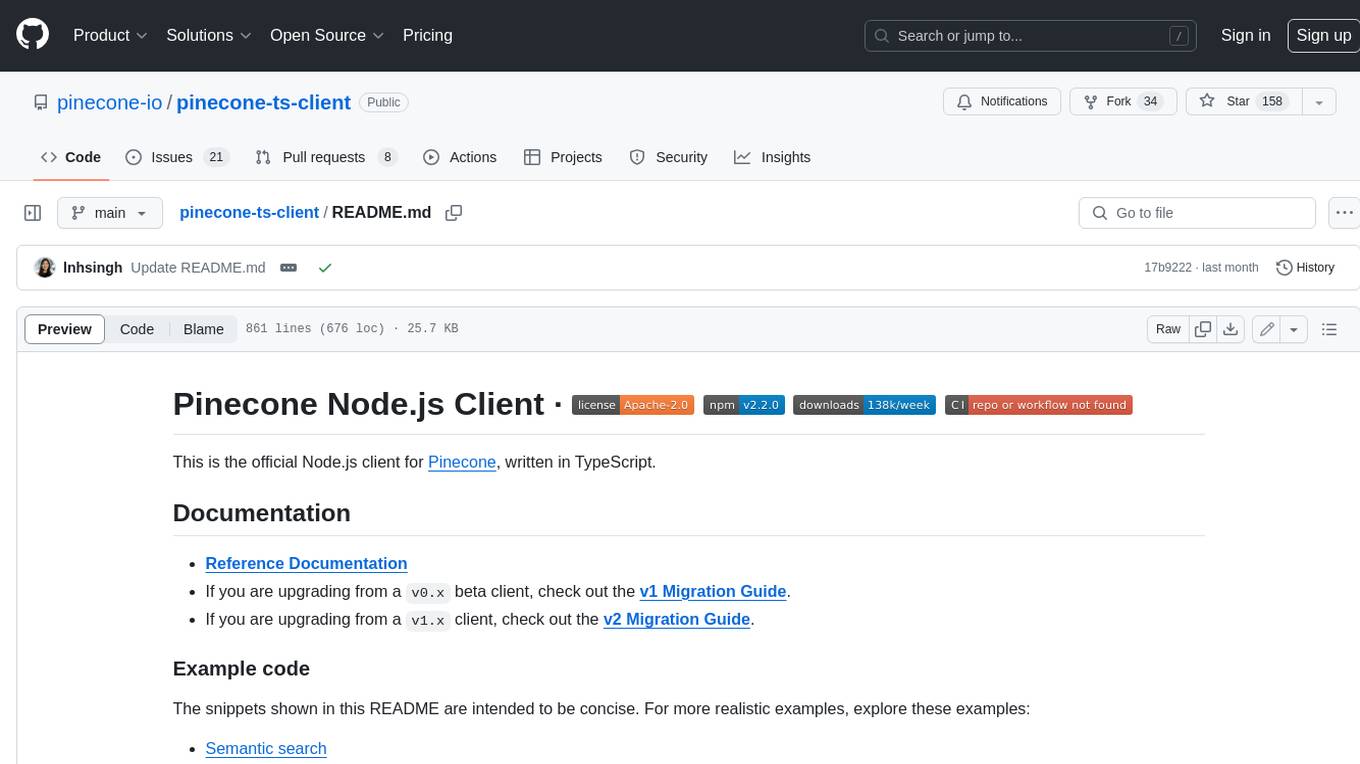
pinecone-ts-client
The official Node.js client for Pinecone, written in TypeScript. This client library provides a high-level interface for interacting with the Pinecone vector database service. With this client, you can create and manage indexes, upsert and query vector data, and perform other operations related to vector search and retrieval. The client is designed to be easy to use and provides a consistent and idiomatic experience for Node.js developers. It supports all the features and functionality of the Pinecone API, making it a comprehensive solution for building vector-powered applications in Node.js.
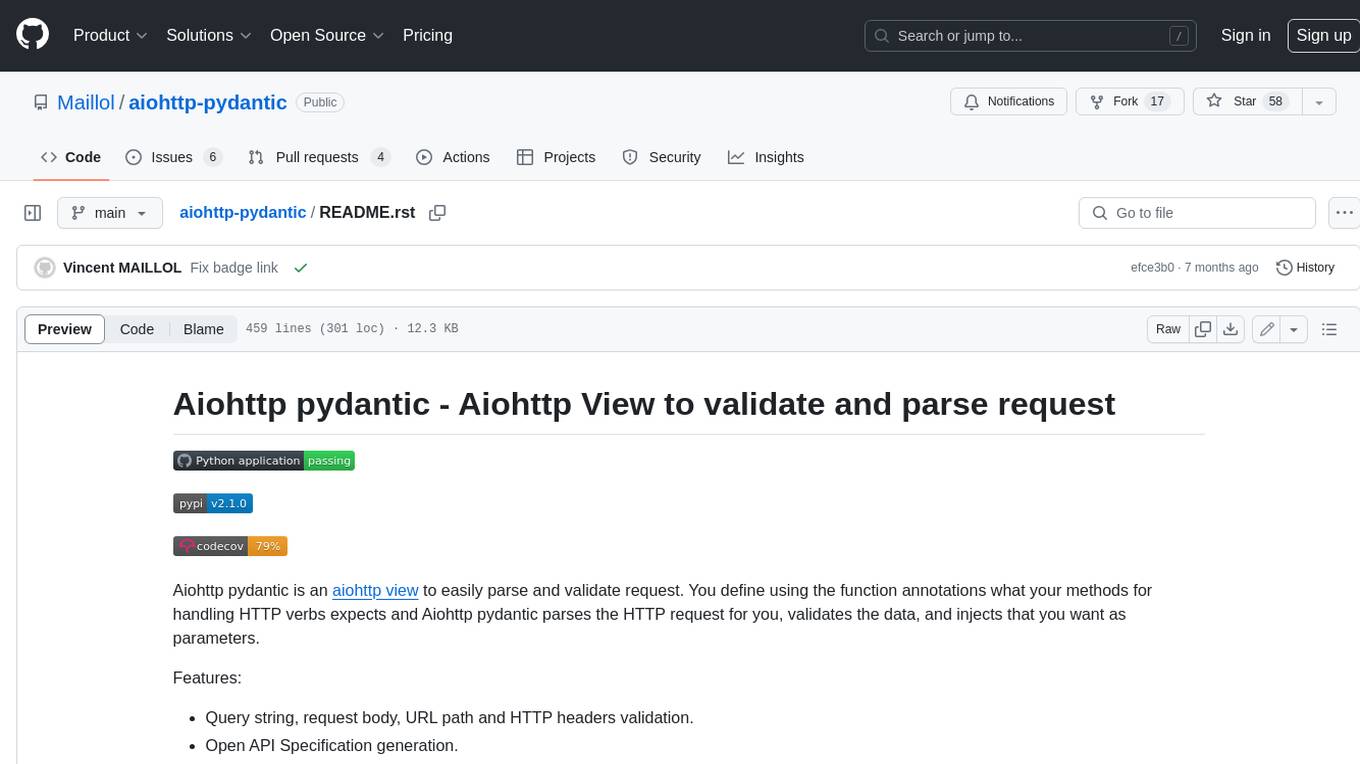
aiohttp-pydantic
Aiohttp pydantic is an aiohttp view to easily parse and validate requests. You define using function annotations what your methods for handling HTTP verbs expect, and Aiohttp pydantic parses the HTTP request for you, validates the data, and injects the parameters you want. It provides features like query string, request body, URL path, and HTTP headers validation, as well as Open API Specification generation.
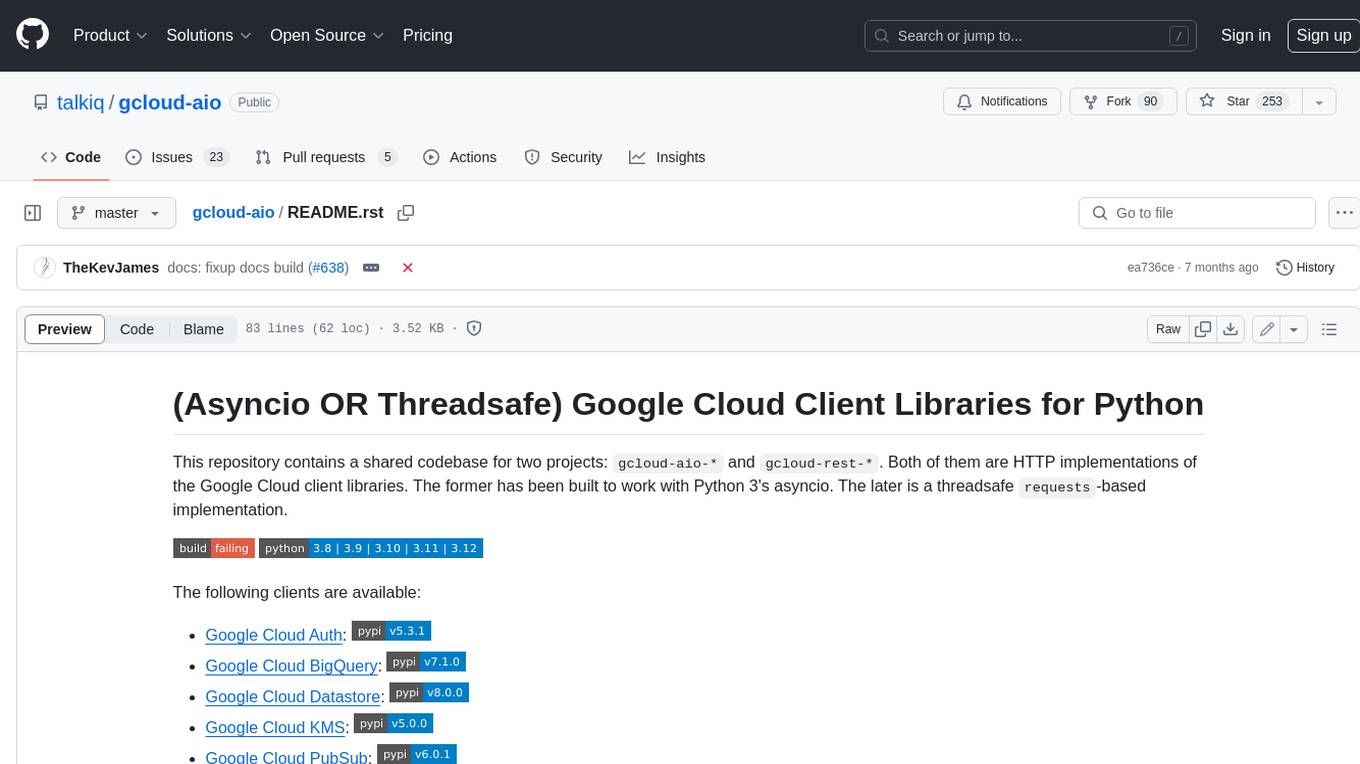
gcloud-aio
This repository contains shared codebase for two projects: gcloud-aio and gcloud-rest. gcloud-aio is built for Python 3's asyncio, while gcloud-rest is a threadsafe requests-based implementation. It provides clients for Google Cloud services like Auth, BigQuery, Datastore, KMS, PubSub, Storage, and Task Queue. Users can install the library using pip and refer to the documentation for usage details. Developers can contribute to the project by following the contribution guide.
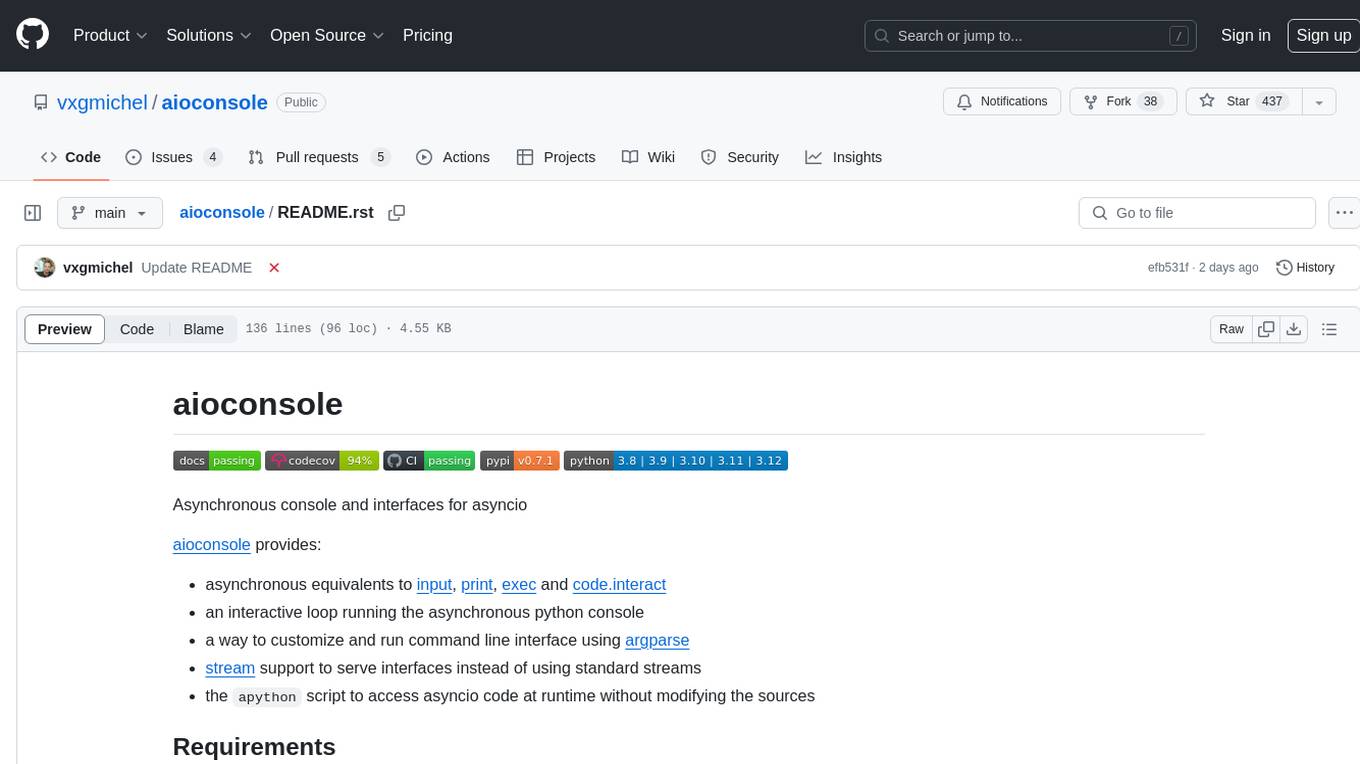
aioconsole
aioconsole is a Python package that provides asynchronous console and interfaces for asyncio. It offers asynchronous equivalents to input, print, exec, and code.interact, an interactive loop running the asynchronous Python console, customization and running of command line interfaces using argparse, stream support to serve interfaces instead of using standard streams, and the apython script to access asyncio code at runtime without modifying the sources. The package requires Python version 3.8 or higher and can be installed from PyPI or GitHub. It allows users to run Python files or modules with a modified asyncio policy, replacing the default event loop with an interactive loop. aioconsole is useful for scenarios where users need to interact with asyncio code in a console environment.
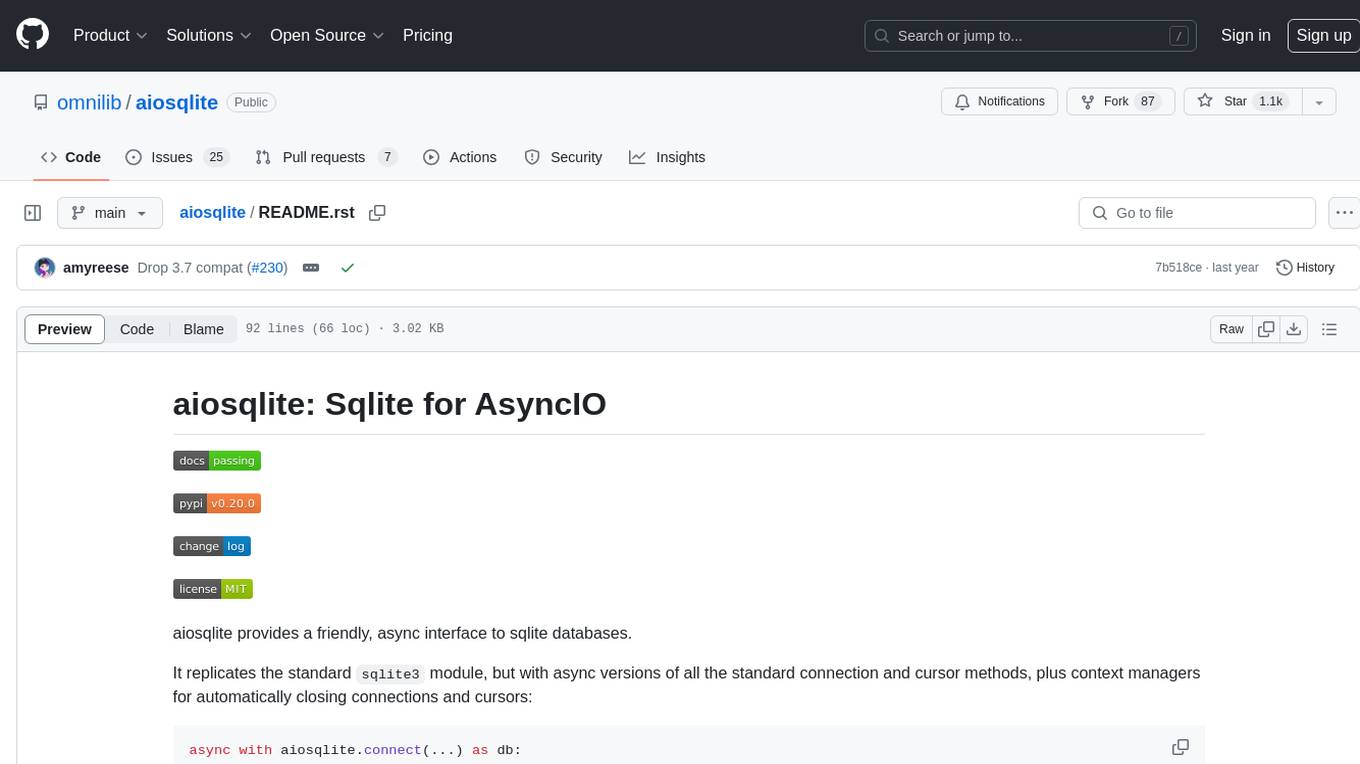
aiosqlite
aiosqlite is a Python library that provides a friendly, async interface to SQLite databases. It replicates the standard sqlite3 module but with async versions of all the standard connection and cursor methods, along with context managers for automatically closing connections and cursors. It allows interaction with SQLite databases on the main AsyncIO event loop without blocking execution of other coroutines while waiting for queries or data fetches. The library also replicates most of the advanced features of sqlite3, such as row factories and total changes tracking.